|
Most cameras on this site are German cameras from the 1930s to 50s, but Japanese Minolta holds a special place in my collection. My first proper camera was a Minolta, a Dynax 500 SLR, as it was the most affordable at the time (mid 90s). When I found out you could buy fantastic older Minolta lenses for reasonable prices I never looked back. Minolta has a long history and was a very innovative company, it is unfortunate it stopped making cameras. However, Sony has taken up the legacy and, after a slow start, it is revolutionising the digital market as we speak. The popularity of its NEX series, together with four thirds cameras of other brands, is even causing a resurgence of interest in vintage lenses. A little to my dismay in fact, as prices of some lenses have recently gone through the roof.
One could build an enormous collection of Minolta cameras very easily, but so far I have restricted myself mostly to cameras that I find interesting and perhaps less well known (update: this is no longer really true...). Eventually I'd like to go further back in Minolta's history but money quickly becomes an issue. The same counts for Minolta's flirtation with Leica style cameras. For the moment I am also trying to stick to my 'no SLR policy', one has to draw a line somewhere!
Minolta Vest
Considering Minolta's success in making compact and SLR cameras, it is probably little known that Minolta started out with making a range of medium format folding and TLR cameras. One of the first was the 1934 Minolta Vest, a 127 rollfilm camera with a 4x6.5 cm frame size having an unusual and innovative segmented collapsible lens construction instead of the more common bellows supported by struts. It shared this feature with the Minolta Six, a larger 120 rollfilm camera, which was introduced a few years later (see below, including a photo of both cameras together). Both the Six and Vest were made of bakelite, also rather unusual at the time, certainly for large cameras such as the Minolta Six.
Several versions of the Vest exist. The first version had chrome-plated knobs and was initially equipped with a Art Deco style Marble shutter, later replaced by a more plain-looking shutter, although still branded Marble. Both had the same fixed focus unnamed f/8 lens. The second version had bakelite knobs instead of chrome. It can be found with at least two different shutter styles, the first essentially being the same as the one on the later version 1 model, the second one had a more decorated face plate and a front-cell focussing lens with faster aperture, an f4/.5 Coronar Anastigmat.

A Minolta Vest (first version, later type) with unspecified lens in Marble shutter, here shown with its original Minolta-branded leather case. The divided viewfinder suggests it could also be used as a square format camera with the use of a mask over the film frame.
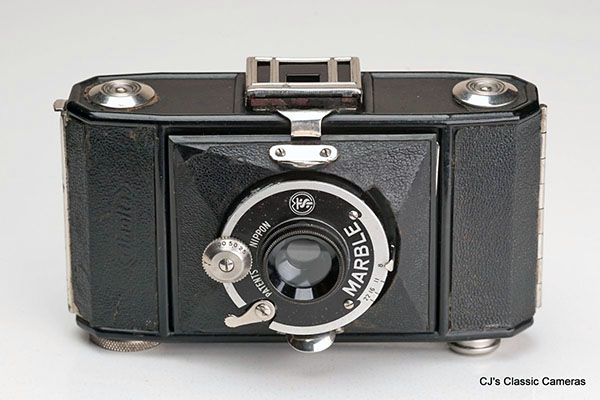
The Minolta Vest folded up into a rather compact package.
Semi Minolta
The Minolta Semi (or more commonly called the Semi Minolta), a 120 rollfilm half-frame (6x4.5 cm in portrait mode) folding camera first introduced at the end of 1934, not long after the Minolta Vest above. It went through many smaller and larger changes, culminating in the Semi Model III just after WWII. This was the first model that had an automatic wind mechanism with frame counter and therefore no longer relied on the 'spy window' at the back of the camera, although it was still present. The camera also featured a double exposure prevention mechanism. A smaller lever at the back would reset the frame counter to zero. Another neat feature was that the viewfinder would flip open when opening the front door. Minolta stopped making folding cameras in the early 1950s.

|
A Minolta Semi II from around 1940 with Coronar Nippon 75mm f/3.5 lens in an everready Patent Nippon Crown shutter. It can be distinguished from the Semi I by having a body-mounted shutter release (next to the viewfinder). This is a late production model with straight struts, earlier variants have engraved joints. The body is covered in a synthetic material that's rather thin and brittle, so it is hard to find these in mint condition.
|
|
A Minolta Semi model IIIa with Chiyoko Rokkor 75mm f/3.5 lens in Konan-Rapid shutter without flash sync, which was introduced on the IIIb. Yes, I know the bellows are missing, this is work in progress :-) This model was the first Minolta camera to sport a lens with the Rokkor name, a name which would survive until the 1980 as the name of choice for compact camera and manual SLR lenses. The Konan-Rapid shutter was nearly identical to the Compur-Rapid. The tripod mount has 'Made in Occupied Japan' engraved.
|

|

A late production (1952-1955) Minolta Semi-P with Chiyoko Promar SII 75mm f/3.5 lens in Konan Flicker shutter with flash sync. The Promar SII was an updated version of the original Promar as found on the Minoltaflex I (see below) and was made by Asahi, from the later Pentax camera range. This model wasn't as advanced as the earlier Model III above, so essentially it was an updated Semi II with a telescopic viewfinder.
Baby Minolta
The 1935 Baby Minolta was, like the Vest above, a 127 rollfilm camera with a 4x6.5 cm frame size. However, the Baby was a much simpler camera, having a bakelite body and a collapsible lens/shutter mount that needed to be pulled out and then rotated to secure it. It had an unnamed fixed focus meniscus achromat lens, presmably the same f/8 model as found on the early Vest variants. The camera had a rounded back, which reflected the shape of the film frame, which was designed to reduce deficiences due to the simple lens. It had two red windows at the back, so could be used in 3x4 format, for which a mask would be needed inside the film chamber. To load film one had to pull the top plate with attached inner frame out of the main body.
Several variants are known. The first had a shutter with an intricate line pattern (see my example below) and an MTS symbol, which represents an early Minolta logo. Small changes to the viewfinder and wind knob were made during production. The second model had a less decorative shutter with thicker stripes. Late production of this model had a bakelite wind knob instead of a chrome-plate one; a similar development as for the Vest.
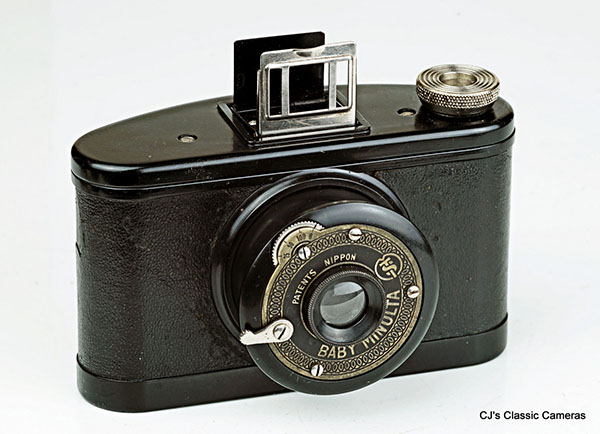
Late production example of the first version of the Baby Minolta with a three-speed shutter and fixed focus lens.
 |
Top view of the Baby Minolta, showing its peculiar shape.
|
Minolta Six
The Minolta Six was introduced in 1936 and was essentially the big brother of the Minolta Vest, namely a 6x6 camera for 120 rollfilm of similar construction. It was produced at the same time as the Minolta Semi, which had a smaller frame size but the same 120 film. I am not quite sure why Minolta decided to build a completely different camera instead of adapting the Semi for a larger frame size, but I am happy they did, as otherwise we would not have had this rather unique camera!

A Minolta Six with Coronar Anastigmat Nippon 80mm f/5.6 lens in Crown shutter. This is a late production example as indicated by the bakelite wind knob, which was metal on earlier production, but the lens serial# suggests it is older than the Minolta Semi II above.
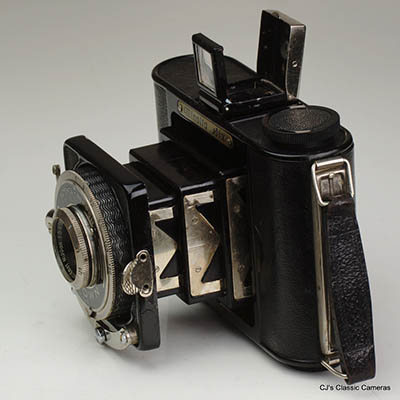
|
Side view of the Minolta Six showing the unusual collapsible lens construction. The metal parts clamped the individual components in place once fully extended.
|

A rather unique pair of cameras, the Minolta Vest and Six. The Six was considerably larger, but the frame size wasn't actually that much larger, 5.6x5.6 cm vs 6.5x4 cm for the Vest.
Minoltaflex I & II
Minolta started making TLR cameras in 1937, as a new member of their rapidly expanding range of rollfilm cameras. The early models were clearly inspired by the Rolleicords and Rolleiflexes, including the focussing mechanism with a focus knob on the side of the camera which would move the whole lens board. Later Minolta TLRs had a different mechanism (see Minoltacord further down). The first Minoltaflex actually looked more like the early Zeiss Ikoflex models than the Rollei ones, with its tapered hood and silvered name plate. Somewhat confusingly, Minoltaflexes had a wind knob like the Rolleicords, whereas the later Minoltacord had a wind lever like the Rolleiflexes. That said, there was a lever wind version of the Minoltaflex, but it was called the Minolta Automat. The Minoltaflex was the first commercially successful Japanese TLR.
|
A late production (1940 or 1941) Minoltaflex I with Promar Anastigmat 75mm f/3.5 taking lens in Crown II shutter. It doesn't actually say Minoltaflex on the camera, the logo is just the name Minolta. It had an automatic frame counter. The lens was made by Asahi, the company behind the Pentax brand, but at the time it had not yet started making cameras.
Also note that both on the shutter and top cover the company name is indicated as Tiyoko, even though the company name was Chiyoda. A short-lived, different translation to western alphabet of the same Japanese character I presume. Early Minoltaflex production still had the earlier MTS logo.
| |
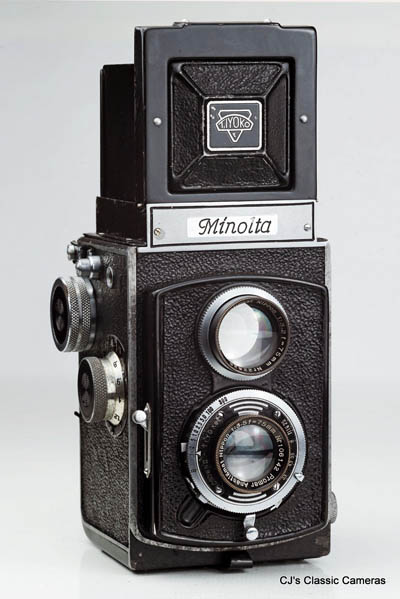
|
The updated Minoltaflex II from 1950 very much looked like a Rolleicord, however, and was similar in operation and performance. The Minoltaflex III had a Bay 3 filter mount like the later Rolleicords instead of the screw mount of the Minoltaflex II.
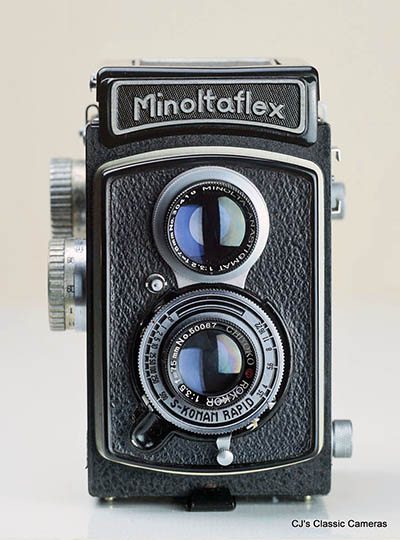
| |
A Minoltaflex II with Chiyoko Rokkor 75mm f/3.5 taking lens in S-Konan Rapid shutter, essentially the same lens-shutter combination as that was used on the later Semi Minolta, such as the Semi IIIa described earlier. The viewing lens was a faster f/3.2 Anastigmat, in order to get a brighter image on the focussing screen. This was not an as high quality lens (otherwise it would of course have been used as taking lens as well) but good enough for framing and focussing.
|
Minolta-35
The Minolta-35 was Minolta's first 35mm camera and what a start it was! It was introduced in 1947 and was clearly 'inspired' by the Leica III range but added several improvements, most notably a single combined viewfinder/rangefinder window, a hinged back door for loading film and a self timer. It was a highly sophisticated and reliable camera with a build quality close to that of the Leicas.
The first version of the Minolta-35 went through several small changes, designated Model A-F, although only from Model-E was this designation indicated on the camera. The film frame of these models was smaller than the common 36x24mm, it started with 32x24 on the Model-A which steadily increased to 34x24 on the Model-F. Other small changes were the size of both the square and round rangefinder windows, and the rewind switch. Additions were a flash sync socket on the Model-E, a dioptre adjustment for the rangefinder eyepiece (Model-E) and strap lugs (Model-D).
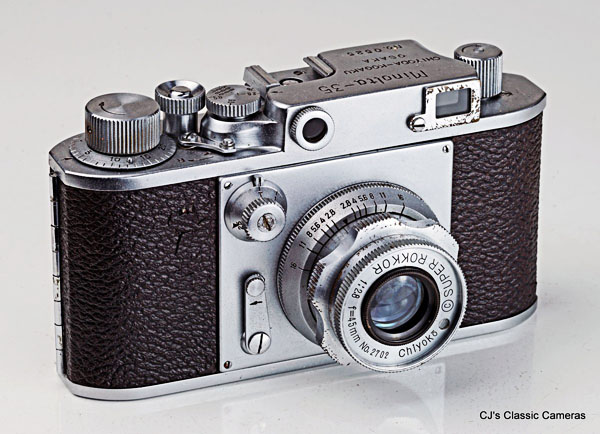
The first version of the Minolta-35, a Model-A with early version of the Chiyoko Rokkor 45mm f/2.8 standard lens. It can be recognised as a Model-A by the sequence of slow speeds (not visible in the photo above though) of 1-2-5-10-25, which changed on the Model-B to 1-2-4-8-25. Yes, we're talking small differences!
The standard lens also went through several smaller and larger changes. The first version was a 5 element lens of 45mm focal length with a prominent scalloped focus ring and was branded Chiyoko Super Rokkor. The lens shape may give the impression its collapsible, but it wasn't. Initial production had a small window in the front ring showing the selected aperture setting, whereas later production had a small lever for easier focussing. A new version with redesigned larger lens body but still branded 'Chiyoko' was available in two speeds, f/2.8 (like the earlier lenses) or a faster f/2, more details follow below.
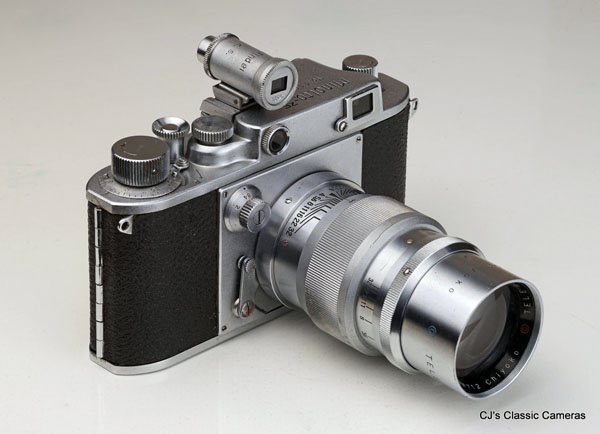
A Minolta-35 Model-D with Chiyoko Tele-Rokkor 135mm f/4 lens and matching accessory viewfinder. This model was the first to have strap lugs, but is otherwise still very similar to the model-A. This particular example has a flash socket at the back, but that's not original, the model-E was the first model with flash sync as standard.
A range of interchangeable lenses was also introduced, including a 35mm f/3.5 wide angle and 85mm f/2.8, 110mm f/5.6 and 135mm f/4 telelenses. These are quite hard to find nowadays, so presumably not that popular at the time and/or held back by today's collectors.
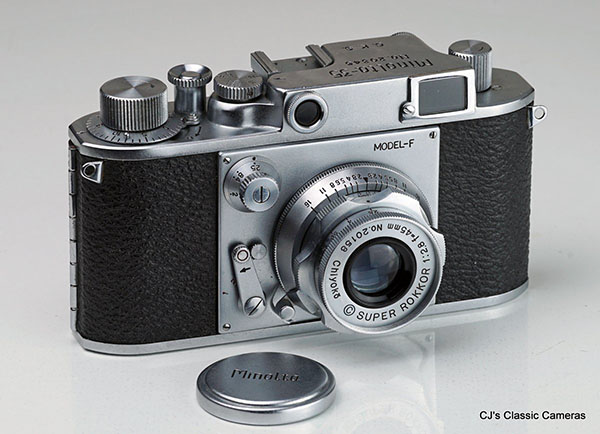
A Minolta-35 Model-F with a late production version of the first model of the Chiyoko Super Rokkor 45mm f/2.8 lens.
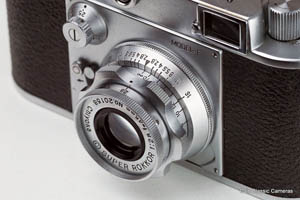
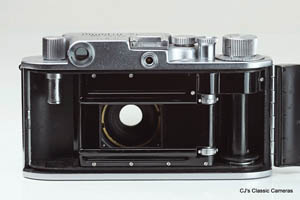
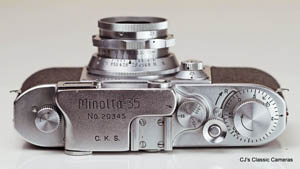
| |
(Top left) Detail of the lens with its characteristic scalloped focus ring. (Top right) Interior of the film chamber, showing the slightly smaller than normal film frame of 34x24 mm, although it is difficult to spot. (Left) The top view shows its Leica heritage more clearly than the front view, with all the controls in the same position and similarly styled as the Leica. Only the rewind lever engages slightly differently.
|
The Model II was introduced in 1953 although it changed little compared to its predecessor Model-F. One positive change was the back release on the bottom plate, which changed from a small button on the Model-A to F to a much more secure rotating knob. The film frame was still 34x24mm, not until the later Model IIB was introduced in 1958 did the film frame increase to the common 24x36 format (see below for example). This was the last model, Minolta from then on focussed on their SLR and compact ranges. By then the Model-35 had been long surpassed by its competitors, which had improved rapidly whereas the Model-35's improvements had been slow and incremental.
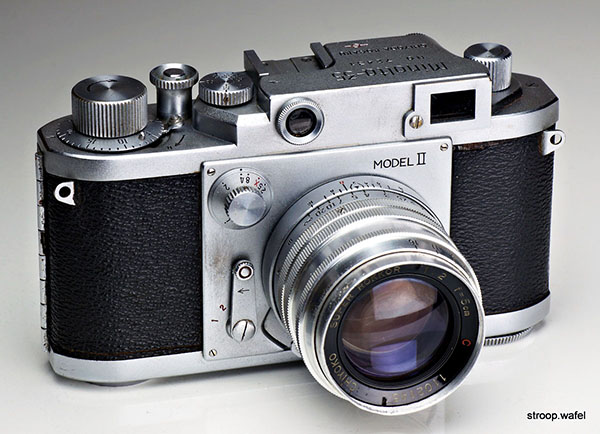
A Minolta 35 Model II with Chiyoko Super-Rokkor 50mm f/2 lens. Some cosmetic changes were introduced to the Model II range in 1955 (most notably the extended top housing under the speed dial), this is an early example of that second version. The Super-Rokkor f/2 lens was also introduced around that time, the first version of the Model II came with the original smaller and lighter f/2.8 lens. The new design was also available as an f/2.8 version.
Note the name engraved on top of the camera is Chiyoda Kogaku, which is the name of the company that built Minolta cameras. Not until the 1960s did the company name itself change to Minolta.

The top view of the Minolta-35 Model II which shows the different shape top housing compared to the Model-F.
The Minolta 35 Model IIB was introduced in 1958 and was the first with a regular 24x36 film film frame. The main other new feature was the single-stroke wind lever, which replaced the wind knob on earlier models. Furthermore, some changes were made to the rangefinder optics so that the viewfinder image was in focus for all distances and its focus didn't need to be adjusted with the ring around the eyepiece, like on earlier models. Finally there were some cosmetic modifications, most notably black plastic speed knobs and frame counter, which gave the camera a more modern look like contemporary Nikon and Canon rangefinders. However, the Model-35 had not really kept up with improvements on other cameras, in particular the small viewfinder, the lack of frame lines and the low top shutter speed of 1/500s reducing the appeal of this camera.

A Minolta 35 Model IIB with Chiyoda Kogaku Super Rokkor 50mm f/1.8 lens. This new black f/1.8 version of the earlier Super Rokkor lens was introduced around the same time as the new model IIB. Note the amber colour of the lens coating, as opposed to purplish blue on earlier lenses. I think this probably means this lens was multi-coated, and in any case has nothing to do with glass of some lenses turning yellow due to the presence of radioactive compounds (thorium glass, used for its high refractive index), as the glass itself is clear.
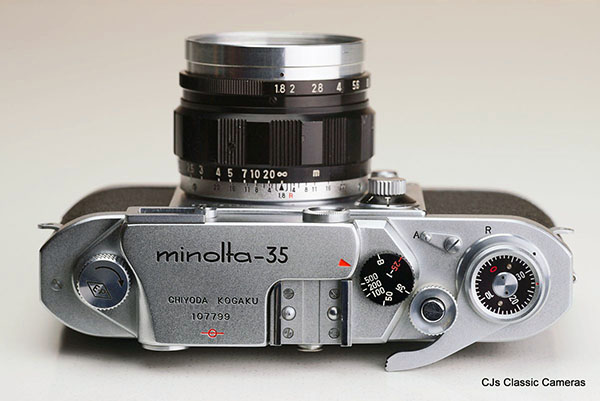
Top view of a A Minolta 35 Model IIB. Despite my criticisms of it, I do really like this camera, it just arrived a little too late. Had it been introduced 5-6 years earlier, it may have had more of an impact.
Minolta Memo
The Minolta Memo was introduced in 1949 and was Minolta's first 35mm leaf shutter camera (the Minolta 35 being its first 35mm camera). It was a fairly simple looking camera with a large central viewfinder and large mostly plastic control knobs and levers, but it did have several quite advanced features for the time, most importantly a wind lever for film transport, as well as helical focussing and a body-mounted shutter release. The shutter was of the self-cocking type, the shutter release included a double-exposure prevention mechanism. The top and bottom of the camera were made of bakelite, but the body itself was made from cast metal.
The Memo was a rather unique camera in the Minolta line-up, and quite unlike any cameras they produced later. Perhaps it inspired later similar looking cameras like the Agfa Clack and the Kodak Brownie. The Memo also came with a lens cap that could be reversed and used as a lens cap, as also found on the later Carl Zeiss Werra. The Memo certainly confirms that Minolta was innovative in its camera designs, in contrast to what is often thought of Japanese companies from that time.
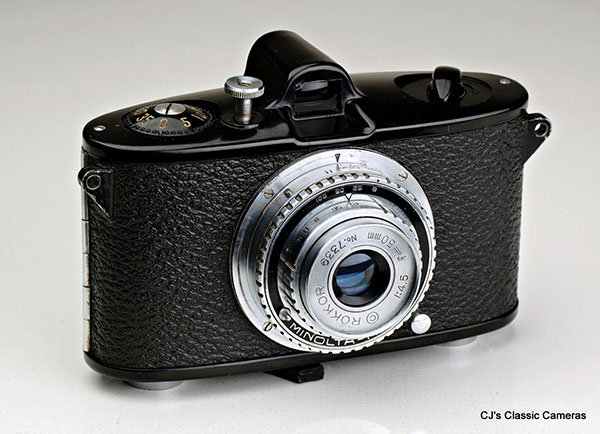
The simple but likable Minolta Memo with its coated Rokkor 50mm f/4.5 lens. The wind lever located at the bottom of the camera stuck out at the front, serving as a stand. Unfortunately, it was rather fragile and often, like on this example, the wind lever is broken off at the edge of the camera.
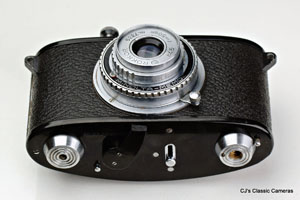
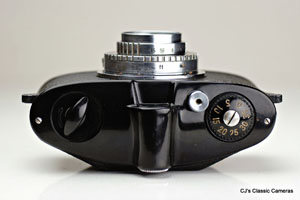
(left) Bottom view of the Minolta Memo showing the broken wind lever, which was positioned a bit strangely and needed to be pulled backwards to advance the film. (right) Top view of the camera, showing its funny body shape.
Minoltacord
The 1953 Minoltacord was the first Minolta TLR which had its focussing lever at the bottom of the lens board, which was a considerable design change from the earlier Minoltaflex (see above). The focus lever would engage the helical focus unit of the taking lens to which the rest of the lens board was mounted. This was similar to (and likely copied from) the way the Meopta Flexaret worked. Despite the name, the Minoltacord had a lever crank winding mechanism like the Rolleiflex line. Unfortunately the shutter still had to be cocked by hand.
There was a choice of three shutters, a Citizen (1s - 1/300, self timer), a Seikosha Rapid (1s - 1/500, no self timer) or an Optiper-MXS (1s - 1/400, self timer, MX synchronisation selector). There were also several top covers, one without any branding and two buttons, one for the magnifying glass and one for the sports finder flap. A presumably later version carried a Chiyoko emblem and would automatically pop up the magnifying glass.
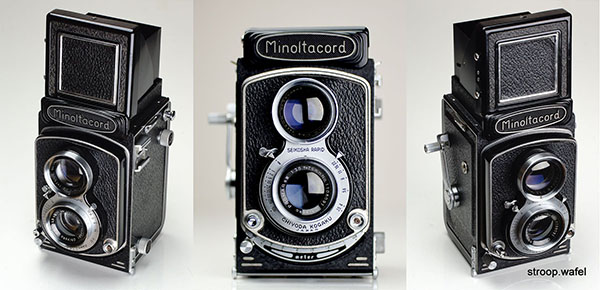
A Minoltacord with Chioyoko Promar SIII 75mm f/3.5 taking lens. The viewing lens was a slightly faster f/3.2. This is the version with Seikosha Rapid shutter and the early style top hood.
Minolta Autocord (LM, CdS)
The Minoltacord above was superseded by the 1954 Minoltacord Automat and in 1955 by the Autocord, both of which were equipped with automatic cocking of the shutter as well as double-exposure prevention. The Autocord also had a Rolleiflex-type bayonet fitting for filters and lens shades, and was equipped with 75mm f/3.5 Rokkor viewing and f/3.2 taking lenses (initially branded Chiyoka, later Minolta). In addition, it had a display on top of the viewing lens that showed shutter speed and aperture setting, again similar to Rolleiflex cameras. An Autocord version with light meter was also introduced, which had a large selenium cell hidden beneath the nameplate. It can be recognised by the large light meter unit on the left side of the camera (opposite from the side with wind lever).
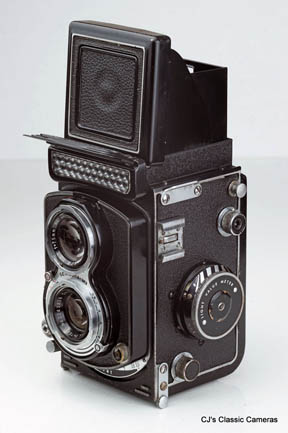
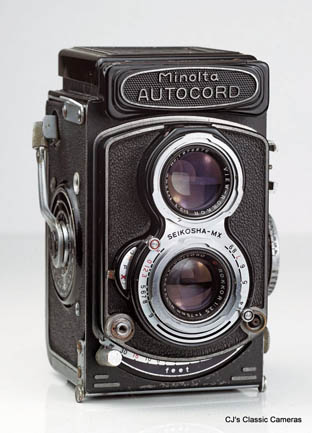
A Minolta Autocord LM with Chiyoko Rokkor 75mm f/3.5 taking lens with the light meter hidden under a flap, so easiest recognised by the light meter unit on its right side (viewing from the front). Move the mouse over the left image to see the flap open and close.
A later variant is the Autocord CdS, which as the name implies had a CdS light meter instead of the selenium cell. CdS light meters needed a battery but were more accurate than selenium cells. The CdS version of the Autocord is easily recognisable by the round battery compartment and CdS unit where the nameplate used to be. The Autocord name was now shown on top of the camera. TLRs with CdS cells are quite rare, their popularity waning by the time this type of light meters were introduced. The Yashica Mat-124 is probably the best known other one.
Quite a few smaller and larger changes were made during the eleven years of production of the Autocord, in fact this excellent overview website lists no less than 24 variants!
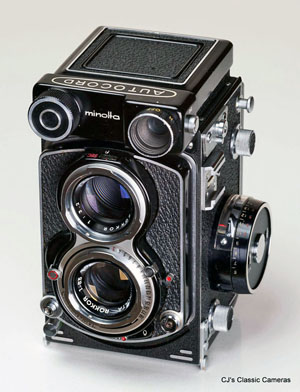

(left) Mirror mirror on the wall, who is the ugliest of them all? I'd say it is probably this CdS I version of the Minolta Autocord due to the bulging light meter contraption on the camera's 'forehead' (right) A much prettier, non-metered Minolta Autocord. This is a later production model (an Autocord II to be precise) which could also be used with 220 film; a switch on the wind crank panel needed to be pushed up after 12 exposures to reset the frame counter and get 24 exposures.
Minolta 'A'
The 1955 Minolta 'A' was a rangefinder camera with leaf shutter. This was one of Minolta's first non-folding 35mm cameras, but it was not Minolta's first rangefinder, that was the Minolta 35 above. The Minolta 'A' had a bulky body with a distinct design. An interesting feature was the serrated wheel for setting the shutter speed on top of the camera. The wind lever appears to be a weak spot in this camera, as the bottom gear is often broken, so if you want to buy one (or the A-2 below), ask if the wind lever moves freely without arming the shutter. If so, better avoid.
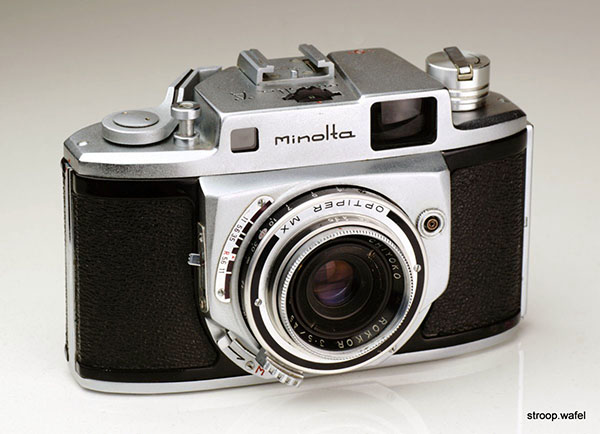
The Minolta 'A' with its rather unique body design. This example features a Chiyoko Rokkor 45mm f/3.5 lens, note that it was not yet branded Minolta. The Minolta A can be found with various shutters, including the Optiper MX shown here, a Citizen MX or a shutter marked Chiyoda Kogaku, found on early production (although I think that is the name of the Minolta company, not the shutter).
Minolta 'A-2'
The 1955 Minolta 'A-2' was introduced around the same time as the Minolta 'A', it was essentially a better specified version with bright frame viewfinder and faster shutter speeds. The shutter speed dial was relocated to make place for the larger viewfinder. Later production of the A-2 had a faster f/2.8 lens.
A very rare version of the A-2 with interchangeable bayonet mount also existed (see below).

A late production Minolta 'A-2' with fast five-element 45mm f/2.8 Rokkor lens.
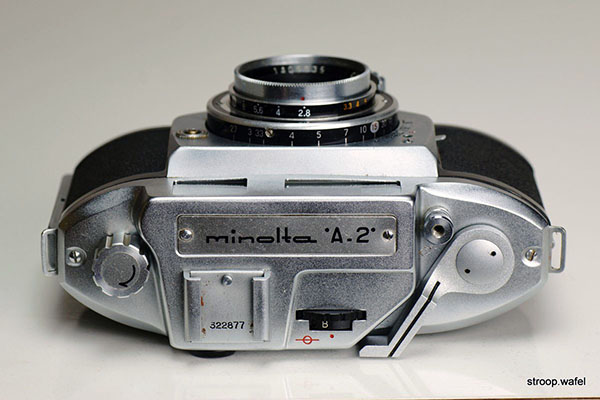
Top view of a Minolta 'A-2'.
Minolta A-2 L
Minolta also made a rare version of their A-2 shown above with an interchangeable bayonet mount. The only available additional lens was a 100mm f/4.8 Tele Rokkor. This model was not to be confused with the Minolta Super-A below, which looked similar but had a wider range of lenses available. It is often called the A-2 LT, but the Collection Appareils website clarified that actually this designation applied to the tele-lens only. What was rather strange is that nowhere on the camera it was indicated that this is a different camera that the original A-2. The only visible clue that this is the A-2 L is that it has a small post next to the lens mount, below the flash sync, which is used for focussing the telelens.

A Minolta A-2 L shown with both available lenses, the original 45mm f/2.8 Rokkor and the new 100 mm f/4.5 Tele Rokkor. Note the small metal post to the right of the lens mount, the only clue that this is the interchangeable lens variant if the standard lens is mounted.
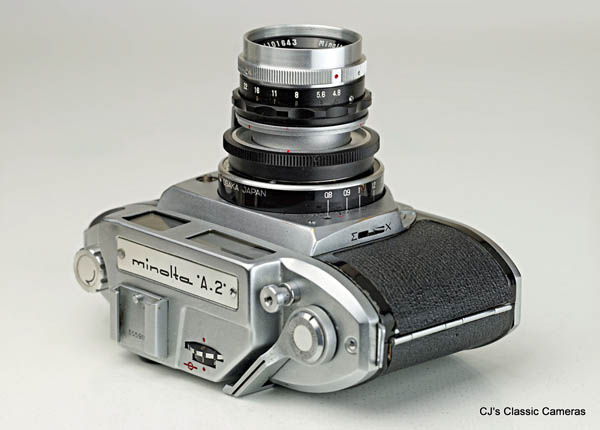
Side view of the A-2 L with the 100 mm f/4.5 Tele Rokkor mounted. It has a small attachment that slides over the post mentioned in the photograph above. I am sure this is meant to automatically adjust the focus of the lens when you move the focus lever of the camera, as the 100 mm lens has a longer focus throw than the 45 mm lens. However, this does not seem to work as designed with my 100 mm lens, and I can't figure out why it goes wrong. I've extended it by hand for the photo, and I've confirmed with a ground glass on the film frame that this is indeed the right focus for the focus distance setting of 0.8 m, but I don't think it works the way it was intended.
Minolta Super 'A'
The 1957 Minolta Super 'A' was essentially a supercharged Minolta 'A-2'. It looked similar but was quite a step up in build quality and had many improved features. First of all it had an interchangeable bayonet mount with a helical focus mount in front of the shutter (so the lenses had no focussing mechanism, like e.g., the Contax and fixed lens Exaktas). Available lenses were a 35mm f/3.5, 85mm f/2.8, 100 f/3.8mm and 135/4.5, all pretty rare to find these days, as well as different speed standard lenses (f/2.8, f/2 and f/1.8). In addition the Super 'A' had a film reminder dial integrated in the wind lever, a pop-out rewind lever, and a depth of focus scale for different focal lengths at the back. What remained was the speed dial on which a light meter could be mounted, resulting in an aperture priority exposure system. A drawback was that all telelenses needed separate viewfinders, as there's a frame in the viewfinder for the 50mm lens only, and for the 35mm lens one could simply use the whole viewfinder. I suppose this camera was probably Minolta's answer to the Leica M3, but never reached much popularity, probably due to its incompatible lens mount.
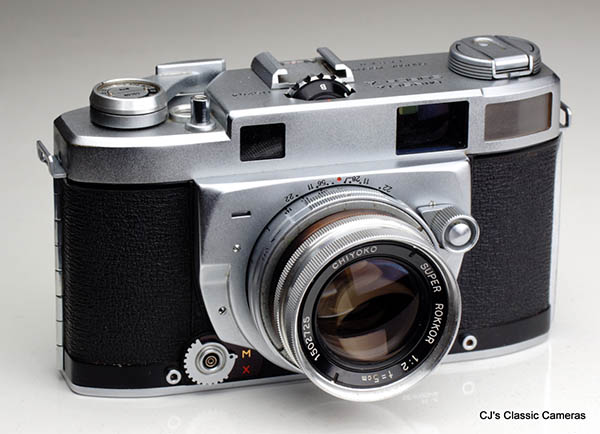
A Minolta Super 'A2' with interchangeable seven-element 50mm f/2.0 Rokkor lens in Seikosha MX shutter. The frosted window to the right of the large viewfinder window is for projecting 50mm frame ines into the viewfinder. This was done via a complex set of mirrors, including a semi-transparent mirror coated partially on both sides, to be careful cleaning these if you're wanting to do so! This complex construction must have been to avoid interfering with the rangefinder, even more so probably because of the location of the shutter speed dial.
(Click images to enlarge) Left: Detail of the Super 'A' bayonet mount. The lens was released by pushing in the centre of the focus lever knob and then twisting the lens counter clockwise. Middle: Top view showing the shutter speed ring on top of the camera. Right: rear view showing the depth of focus guide. The black plastic cover next to the eye piece gave access to the rangefinder adjustment screws.

A Minolta Super 'A2' with the faster and more rare 50mm f/1.8 Super Rokkor lens, which came out later as an upgrade to the f/2, but it is a six-element lens. This is the same lens as the Super Rokkor introduced for the Minolta 35 IIb, discussed earlier on this page, but apparently the Super-A version came out first. The camera also has a Minoltameter mounted, which was coupled to the shutter speed selector knob (just visible in the picture), similar to the Leicameter on the Leica M range.
Minolta Auto Wide
The Minolta Auto Wide appeared in 1958 and love it or hate it, it certainly was an eye-catching model. The large protruding light meter cell, which also housed the shutter release (!), made it look like it was wearing a monocle. It was marketed as the "world's first automatic camera with 35mm. wide vision lens". It featured a 6-element Rokkor f/2.8 lens of very good quality. It was a viewfinder camera, but due to the wide angle lens, depth of field was larger than usual, so focussing errors were less problematic. In fact, the camera features a zone focus system, although one could read the exact distance if needed. The wind lever and rewind crank were located on the base of the camera.
Like other 'automatic' cameras of that era, it featured a coupled light meter: whilst adjusting the exposure a marker would move in the light meter window, the aim was to align the two to get the proper exposure. The Auto Wide had a unique way of doing this, it had an adjustment wheel at the back of the camera, the outer ring would change the shutter speed, the inner wheel would adjust both aperture and shutter speed whilst keeping the LV constant.
This is not an easy camera to work on, as shown in the pictures below. The shutter is mounted backwards, so the aperture is in front of the shutter. To clean the shutter, one needs to take apart most of the camera, including the shutter cocking mechanism connected to the wind mechanism.
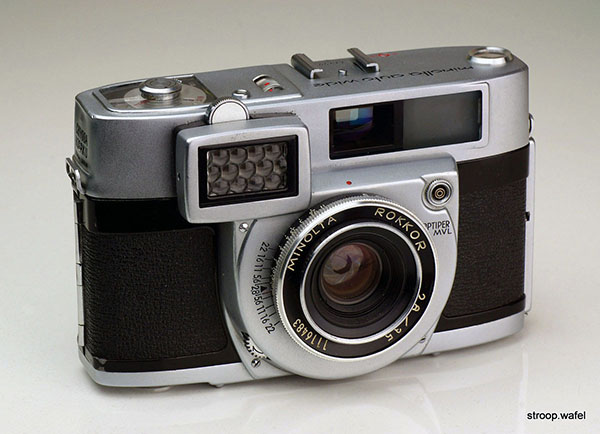
A Minolta Auto Wide with its characteristic light meter cell. Note that the aperture is visible in front of the leaf shutter as the shutter unit is mounted front to back.
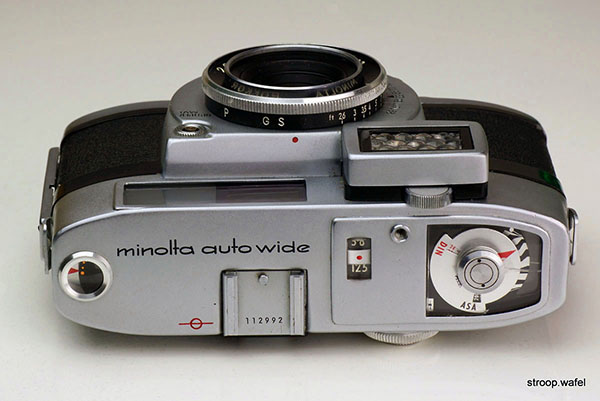
Top view of a Minolta Auto Wide showing the automatic light meter system. Also note the zone focussing marks on the focus ring.
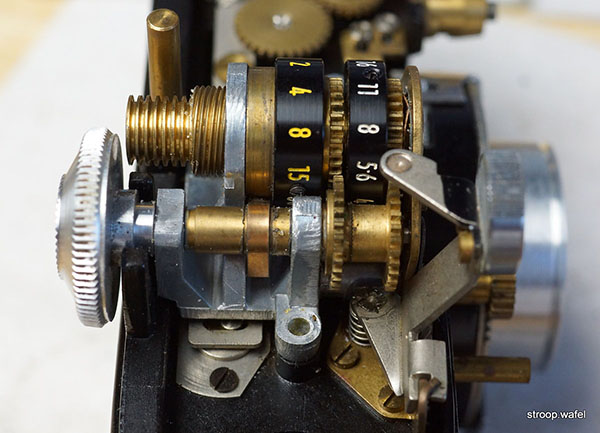
Detail of the Auto Wide's gear system of the 'automatic' exposure unit. Note that each aperture and shutter speed combination adds up to the same light value.
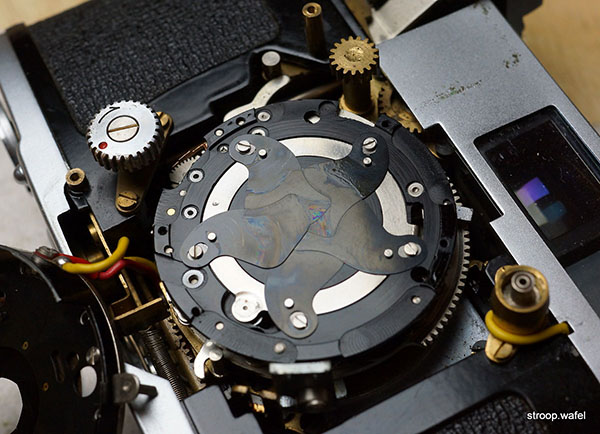
Auto Wide leaf shutter with most of the front end disassembled. These rather greasy looking blades were sticking together on this particular camera.
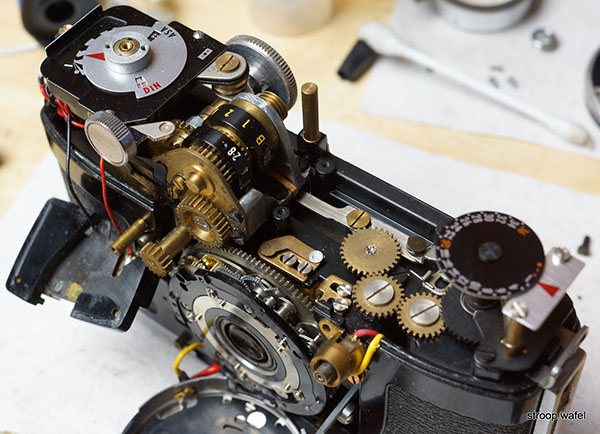
Auto Wide shutter unit after removal of front end and rangefinder, detailing the coupling of the automatic exposure unit to the shutter speed and aperture rings.
Minolta V2
The 1958 Minolta V2 appeared around the same time as the Auto Wide but had a much more modern look. It was a rangefinder with a for that time incredible fast shutter speed of 1/2000 second. Something that was not immediately clear in the advertisements is that it achieved this by not fully opening the shutter at the highest speeds, hence one could only use an aperture of f/8 or smaller at 1/2000s and f/4 or smaller at 1/1000s. The lens was a fast and sizeable 6-element Rokkor-PF f/2.0 and had a closest focus distance of 2.6 feet. The camera also featured parallax correction.
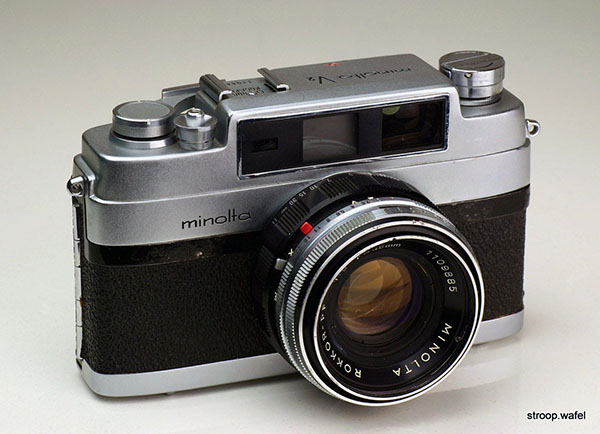
A Minolta V2 in reasonable cosmetic condition. The lens has a lot of dust but has thus far resisted my attempts to open it.

A Minolta V2 from above, dominated by the large and excellent Rokkor f/2 lens, with all the exposure controls on the lens itself instead of on the camera body like earlier models.
Minolta SR-1
Whilst doing lots of development with their rangefinder cameras, Minolta also started to invest in SLR cameras. The first one was the SR-2 in 1958, the SR-1 came a year later. The cameras had several advanced features not often available on contemporary SLRs, including an auto-return mirror so that the viewfinder would not black out after taking a shot, and an automatic aperture, which would stop down to the preset value when releasing the shutter, allowing focussing at fully open aperture. The main difference between the SR-2 and SR-1 was that the latter had a slower top shutter speed and a slower standard lens, and was considerably cheaper. This was a common strategy at the time: introduce the expensive camera first to get production going and get a high profit for each camera, then release a cheaper version to increase sales volume.

A Minolta SR-1 SLR camera with Rokkor-PF standard lens. It was a nice and clean looking SLR, and the design was quite typical of other Minolta cameras from that time. Later production of the SR-1 could be fitted with an accessory light meter that would connect to the speed dial, but this is an earlier example recognisable by having the SR-1 logo engraved beneath the speed dial, instead of beneath the rewind knob.
The lens mount on the Minolta SLR was a bayonet mount, which had a few features added over time but stayed essentially the same until the A-mount was introduced. Hence, about four decades of lenses can be used on most Minolta manual focus SLRs, although of course not all features of the lens may work on older bodies.
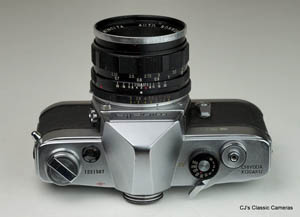
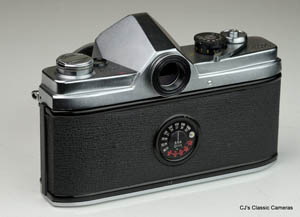
Top and rear view of the Minolta SR-1 SLR camera. Note the company name was still indicated as Chiyoda Kogaku. The back door of the camera featured a film speed reminder dial.
Minolta A 3
Introduced in the last year of the 1950s, the Minolta A 3 was a very different and much more modern looking camera than its predecessor the A 2. It was the first Minolta with a flat top plate with integrated rewind knob, a design that laid the base for nearly all future Minolta 35mm cameras. Like the Minolta V2 above it had a prominent lens with all exposure and flash controls integrated. It had a slower Rokkor-TE or TD f/2.8 lens and a slower top speed of 1/500 compared to the V2, but it made up for this in portability. The compact camera was born!

A Minolta A 3 with Rokkor-TE 45mm f/2.8 lens, the first modern-looking 35mm camera by Minolta. A quick word about the two-character Minolta Rokkor lens designations may be useful here, these represent the optical design as follows: the first character indicates the number of lens groups: T (Tri)=3, Q (Quart)=4, P (Penta)=5, H (Hexa)=6 (an amusing mix of Greek and Latin prefixes), the second character the numbers of lens elements in simple alphabet code (so D=4, E=5, F=6). Thus, the Rokkor-TE on this Minolta A 3 is a lens with five elements in three groups.
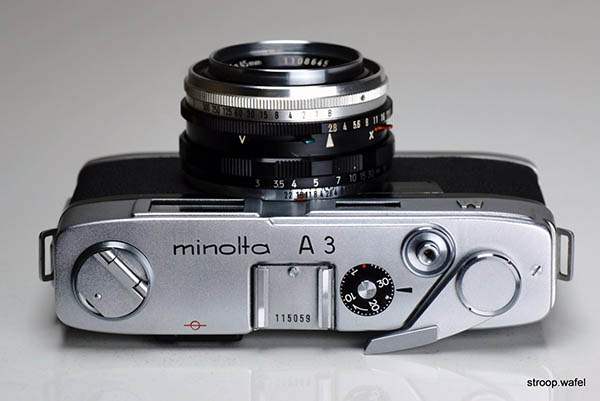
A Minolta A 3 with Rokkor-TE 45mm f/2.8 lens. The red circle with a line through it indicates the position of the film frame.
Minolta A 5
The 1960 Minolta A 5 was, like its predecessor the A 3, a modern looking and compact rangefinder, and one of the last Minolta compacts without a light meter.
Two different body designs exist. The first version had had a large glass front plate behind which the rangefinder windows could be found. Otherwise it looked similar to the A 3, with 'Minolta' printed on a small patch next to the lens base and the wind lever on top of the camera. It had a fastest shutter speed of 1/500s; a version with a faster 1/1000s also existed. The lens was a Rokkor/Rokkor-TD 45mm f/2.8 or a Rokkor-PF 45mm f/2 lens.
A later, second version incorporated quite a few design changes and looked more like the Minolta ALS. It had separate rangefinder windows and 'Minolta' was engraved on the front of the top housing. The wind lever was located at the back of the camera, which also featured a hot shoe. The lens was a Rokkor 40mm f/2.8.

The first version of the Minolta A 5, here with Rokkor f/2.8 lens.
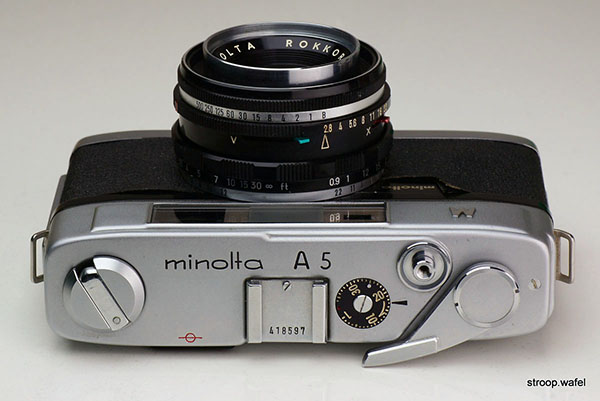
Top view of a Minolta A 5, very similar to that of the A 3 with a somewhat old-fashioned looking frame counter but a newly designed rewind knob.
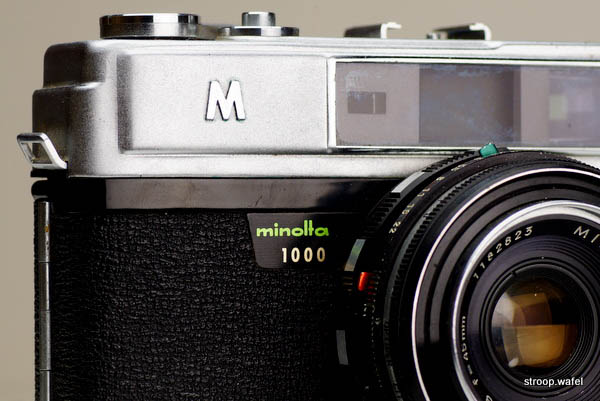
The A 5 was also available with a top shutter speed of 1/1000s, these models were marked '1000' below the Minolta logo next to the shutter.
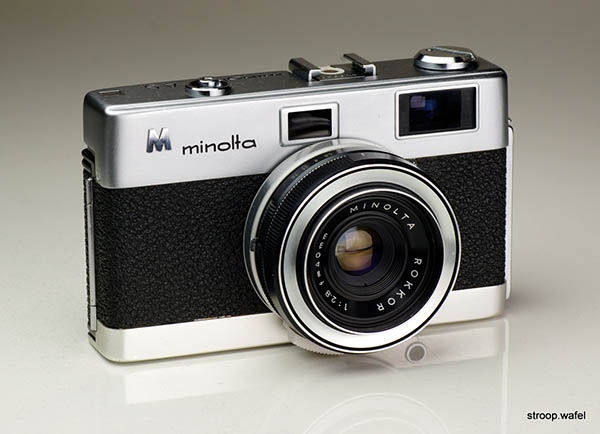
The second version of the A 5 featured a nearly completely redesigned body and received a hot shoe. It sported a 40mm f/2.8 Rokkor lens and had Minolta engraved on the front.
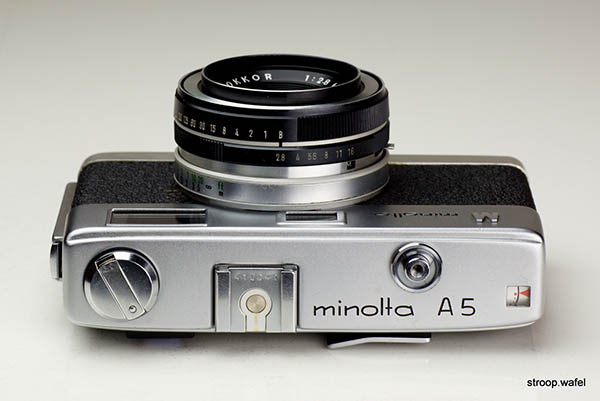
Top view of the new version of the A 5 with a thinner body and new-style rapid winder, frame counter and hot shoe. Considering all the changes it is a little surprising that Minolta chose to keep the same model name.
Minolta AL
The 1961 Minolta AL was essentially a Minolta A 5 (the early version) with coupled light meter. It had a fast shutter top speed of 1/1000s, the lens was a Rokkor-PF 45mm f/2 lens. The addition of a light meter meant the frame counter had to be moved; it was located at the bottom of the camera. The accessory was relocated closer to the rewind crank. A cover on the top plate plugged the hole intended for the frame counter on the Minolta A 5, but it was removable by twisting it to allow access to the rangefinder adjustment screws. A small window showing the light meter needle was located on top of the camera, the match needle window. Adjusting the shutter speed or lens aperture until the needle lined up with the exposure indicator mark would result in the right exposure. Although the Minolta AL was supposedly introduced a year after the Minolta A 5, the rewind crank was the same as that of the Minolta A 3.

A Minolta AL with Rokkor-PF 45mm f/2 lens. This was a bit of a dud, rangefinder off vertically as well as horizontally, some screws missing, someone snapped the internal light meter wires and it the lens infinity focus appears to be off. But the shutter worked like a charm and the lens was clear, so worth giving it some TLC.

Top view of a Minolta AL showing the match needle window.
Uniomat
The 1960 Minolta Uniomat was one of the first cameras with a programmed shutter controlled by the light meter. One would simply set the film speed and turn the exposure control ring until the desired light meter setting; the camera would select shutter speed and aperture. An LV scale on the shutter could be used to adjust exposure, but independent control of shutter speed or aperture was impossible. In fact, the camera has only one set of blades, so the shutter would not completely open as to mimic various aperture settings. When changing the exposure control ring one can see the shutter blades moving into different positions. Slow shutter speeds would use large apertures and fast shutter speeds used small apertures. This clearly aimed to be a point and shoot camera. The camera also featured flash exposure markings on the exposure control ring, all one needed to do was align the distance marker with the marker for the type of flash bulb and the exposure was correct.
A later version (1961) had a restyled rangefinder window with a white frame including the name Minolta in silver lettering. It was one of the few Minolta cameras that did not have the brand name engraved in the body. It also featured a flash guide table on the back of the camera.
A third version (1963) had a circular selenium cell light meter around the lens. The name Minolta was engraved where the selenium cell used to be on the Uniomat II. There was a lever at the bottom of the lens barrel to set the film speed, which was different from the previous model where one had to pull back and turn the setting ring closest to the body.

The first version of the Minolta Uniomat with a 45mm f/2.8 Rokkor lens.
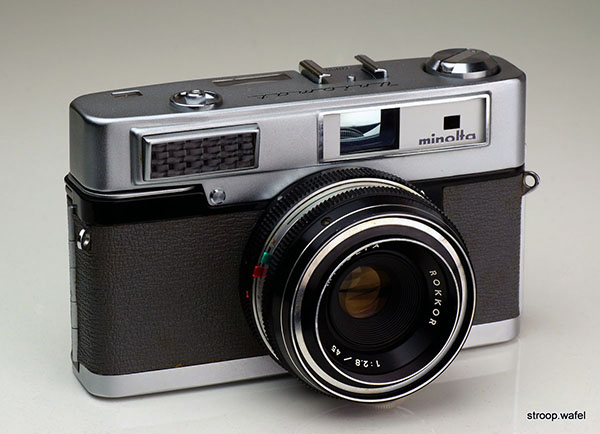
The second version of the Uniomat with a for Minolta somewhat uncharacteristic grey covering.
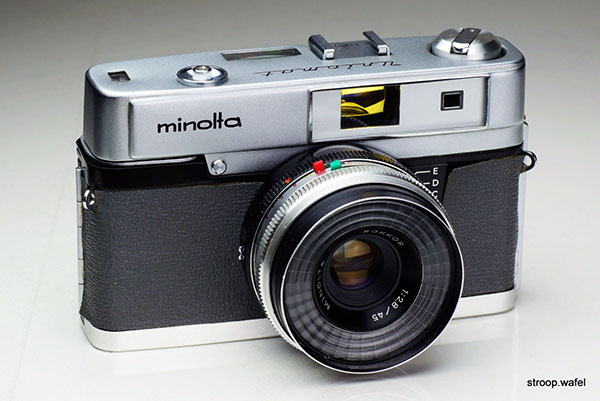
The third version with light meter around the lens and Minolta engraved on the front where the light meter cell was on the previous version.
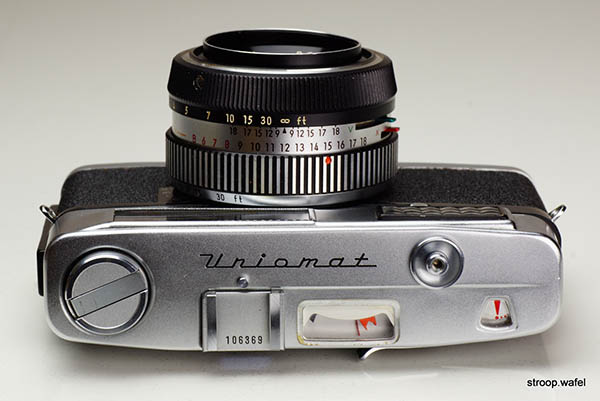
Top view of the Minolta Uniomat I. The frame counter resets automatically when the back of the camera is opened, showing red dots for the first few frames.
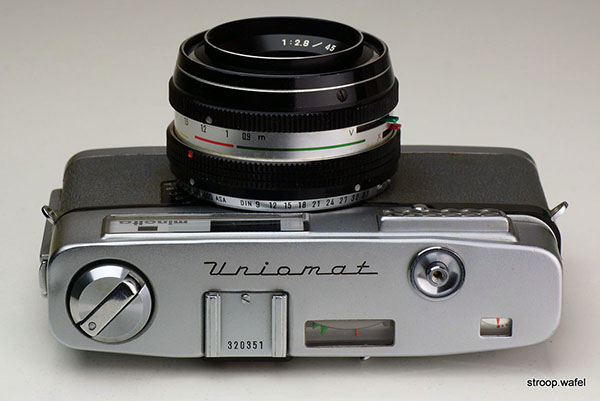
Top view of the Minolta Uniomat II. The A-E flash guide markings are just about visible on the left side of the lens. The top plate of the Uniomat III is nearly identical apart from the position of the frame counter which was rotated 90 degrees and moved to the edge of the top housing.
Minolta-16
The Minolta-16 was first introduced in 1955, it was a subminiature camera that used the 16mm film format. Film was available in small cassettes. Early models had a body pull and push shutter advance, later models had a fixed body with a thumb wheel for film advance. The Model-P was one of the latter. It was a manual camera without light meter. Despite its small size it did have all the features of contemporary cameras, such as a flash sync socket and a tripod mount.

A 1960 Minolta-16 Model P with 25mm f/3.5 Rokkor lens, shown with its original fitting case. It was a fully manual camera with fixed shutter speed, the aperture was set with a dial on top of the camera (here shown at the front).

Bottom side of a Minolta-16 Model P. This part of the camera could be opened in order to load a 16mm film cassette like the one shown in the picture.
Hi-Matic
The 1962 Hi-Matic was the first in the long line of Hi-Matic cameras that Minolta produced until well into the 1980s. It was a rangefinder camera, the viewfinder image would show the light meter needle. Both shutter speed and aperture were set automatically, although the camera also had an aperture priority mode.
This camera has somewhat of a reputation on the internet, as it was sold in the U.S.A. under the name 'Ansco Autoset', one example of which was taken into space in 1962 by John Glenn during one of the Mercury missions. It was modified by NASA to be handled whilst wearing a space suit. The main selling point was the fact that is was fully automatic. More info and images can be found on this blog, which also debunks some of the myths surrounding this camera. It sure looked little like the original!
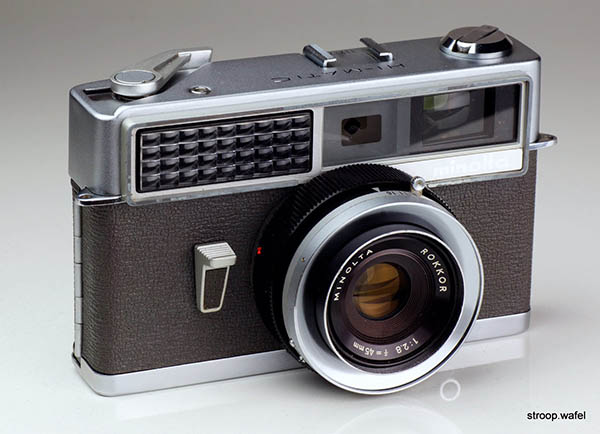
A Minolta Hi-Matic with its exceptionally large light meter window, which makes the camera look smaller on photographs that it actually is. This example focus was stuck and the shutter did not fire. It turned out that the helicoid had seized, unusual for Minoltas. The shutter mechanism was similar to that of the Uniomat: instead of having a separate aperture, the shutter would open partially only.
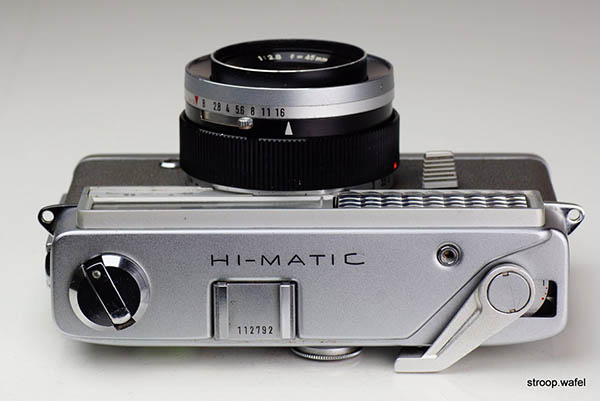
Top view of the Hi-Matic, not much going on.
Minolta AL-2
The 1963 Minolta AL-2 is a bit of a rarity, at least in this part of the world, as it appears to have been made for the Japanese market only. Clearly, it is a successor of the Minolta AL, but it has quite a few features of the Hi-matic, including how the top housing is cut out around the wind lever, the shape of the strap lugs, the large frame counter window beneath the wind lever. Curiously, the wind lever is unusual and can only be found on the Minolta-build Ansco Autoset CdS. Compared to the original Minolta AL, the AL-2 had a narrower rangefinder base, which allowed for a slightly larger light meter. It had a slower top shutter speed of 1/500s, but a faster f/1.8 lens, and may well have been the first Minolta to feature this lens, found later on the Hi-matic 7 and 7s.
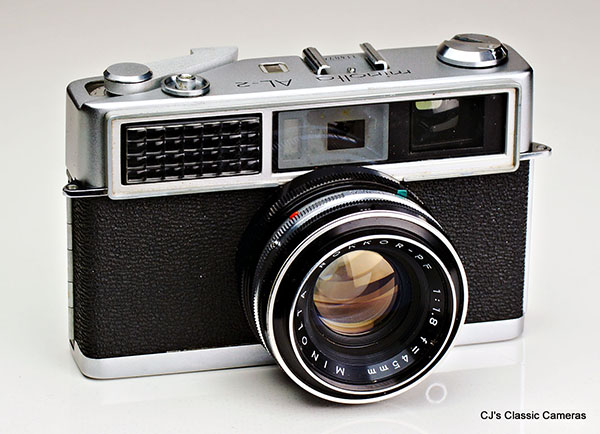
A Minolta AL-2 with Rokkor-PF 45mm f/1.8 lens.

Top view of a Minolta AL-2, which looks like a hybrid of the original Minolta AL and the Hi-matic.
Minolta-ER
The 1963 Minolta-ER was a leaf shutter SLR with fixed lens and semi-automatic exposure where the camera would control the aperture based on a preselected shutter speed. Thus it was comparable in features to the Braun Paxette Reflex, Zeiss Ikon Contaflex and Agfa Colorflex but, in my opinion, a whole lot uglier. Quite why Minolta brought this out, I am not sure. It was outdated by the time it was introduced and sold predictably poorly. Evidence that even Minolta didn't always get it right!
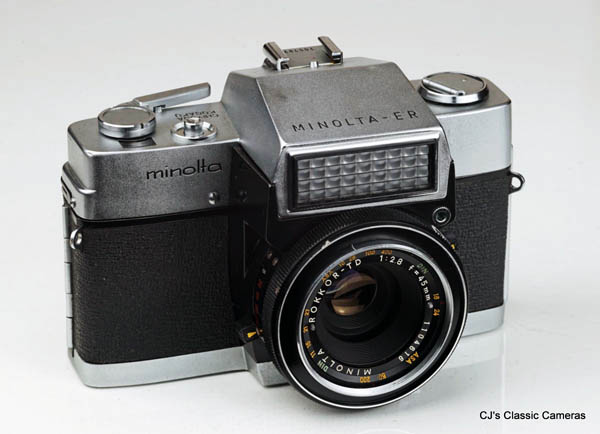
Minolta-ER with Rokkor-TD 45mm f/2.8 lens (with four elements in three groups). Its style of rewind knob was last used on the Minolta AL, which was already a few years old at the time, which suggests the ER had been in development for quite a while before it was introduced. This is also implied by the somewhat outdated exposure mechanism, after all the fully automatic Hi-Matic had already been introduced a year earlier.
Repo
The 1962 Minolta Repo was a half-frame camera, which means it had a 18x24mm frame size in portrait mode. Instead of a wind lever the camera had a wind wheel which one could operate with one's thumb. It was a simple looking camera without any frills. The camera had a single exposure setting ring which controlled both aperture and shutter speed, a needle-matching light meter would indicate the right setting. In flash mode the shutter speed was set to 1/30 and aperture could be set independently. Two slightly different versions were produced, the first had the light meter and viewfinder window housing protruding from the top of the camera, whereas the second version had a flat top housing. A fully black version was also available.
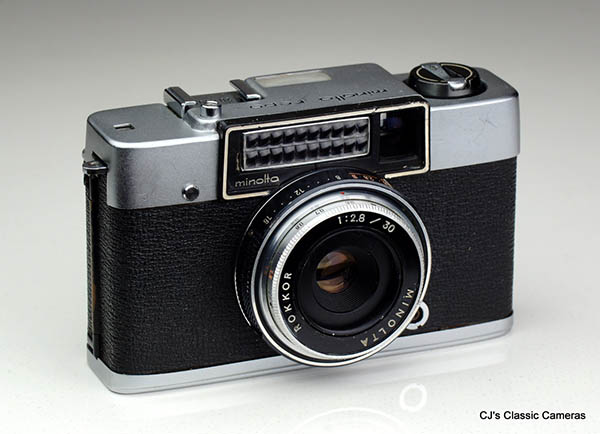
First version of the Repo with 30mm Rokkor f/2.8 lens. The short focal length is equivalent to a standard lens on a full frame camera. The Repo is by far the smallest Minolta camera on this page.
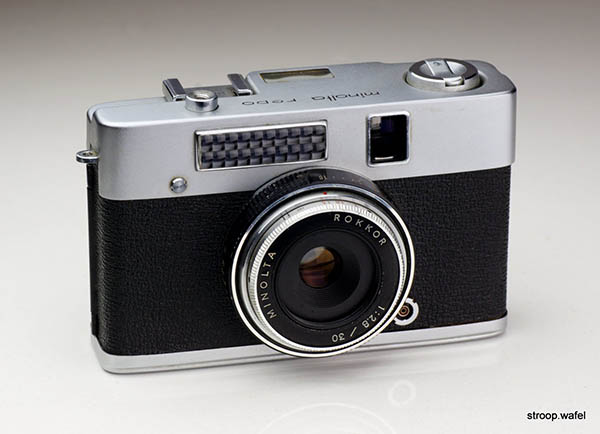
The second version of the Repo.

Top view of the Repo, a very well-featured camera for its small size.

Rear view of the Repo showing the half-frame film gate. This frame size may seem small, but was still slightly larger than the APS-C format used for the sensors on most modern DSLRs! Note the thumb wheel used for advancing the film.
Repo-S
The 1964 Minolta Repo-S was a more attractive looking update of the original Repo above and featured a wind lever instead of a thumb wheel, as well as a faster f/1.8 lens. Due to the faster lens it was slightly heavier and larger than the original Repo, but still small for its impressive specifications. Like the Repo, it was a fully manual camera.
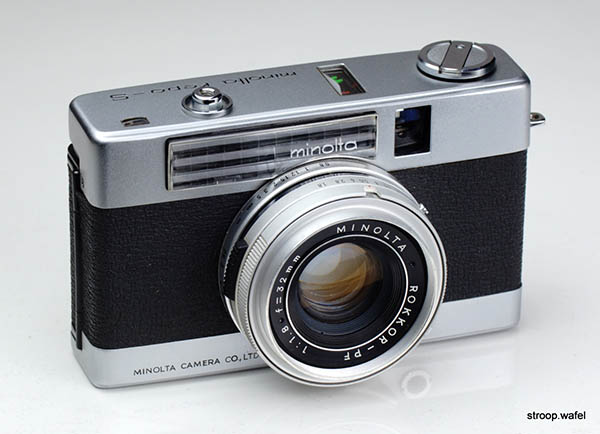
A Minolta Repo-S with 32mm Rokkor-PF f/1.8 lens.

Top view of the Minolta Repo-S, looking much less cluttered than its predecessor.
Minoltina-P
The 1964 Minoltina-P was a very small point and shoot camera that would easily fit in a jacket pocket. It featured automatic exposure control similar to the Uniomat. A nifty little feature was the focus indicator next to the light meter window on top of the camera, thus all controls were visible in one glance. The lens was a relatively short 38mm f/2.8.
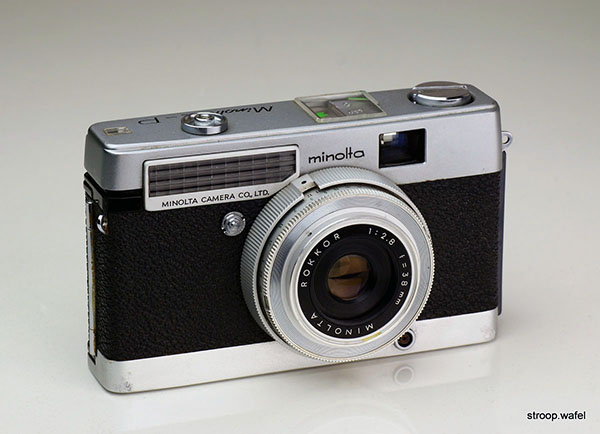
A Minoltina-P. The little knob left of the lens is the time delay.
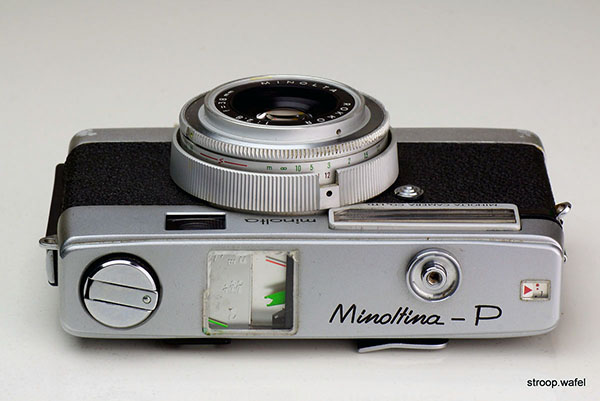
A Minoltina-P from above showing its small form factor. Note the focus indicator next to the light meter window.
Minoltina-S
Only little larger than the Minoltina-P, the 1964 Minoltina-S was at the time the smallest rangefinder camera with coupled exposure metering. Exposure setting was fully manual, one could set aperture and shutter speed independently. The lens was a fast 40mm f/1.8 Rokkor-QF.
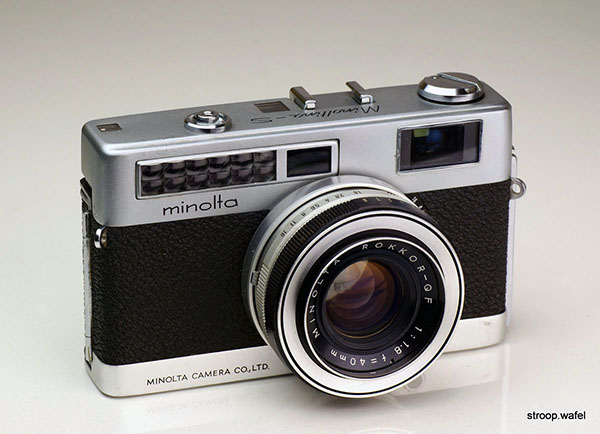
The Minoltina-S, a great little rangefinder camera with full exposure control and a fast lens.

Top view of the Minoltina-S with its miniscule but adequate light meter window.

Seiko-SLV shutter of the the Minoltina-S, very similar to the Synchro-Compur style of shutters. Luckily not mounted back to front like on earlier Minoltas!
Minolta ALS
Not to be confused with the Minoltina AL-S, a name variant of the Minoltina-S above, yet closely related, as the 1966 Minolta ALS was essentially an updated version of that camera with CdS light meter. This was the only Minolta compact camera I am aware of that had a CdS light meter mounted on the top housing. On most models the light meter was located near the lens, which had the benefit of automatically correcting exposure if filters were mounted. I assume the position of the light meter was kept the same to avoid redesigning the lens mount. Another upgrade was the hot shoe, but lens and exposure range were the same as on the Minoltina-S.
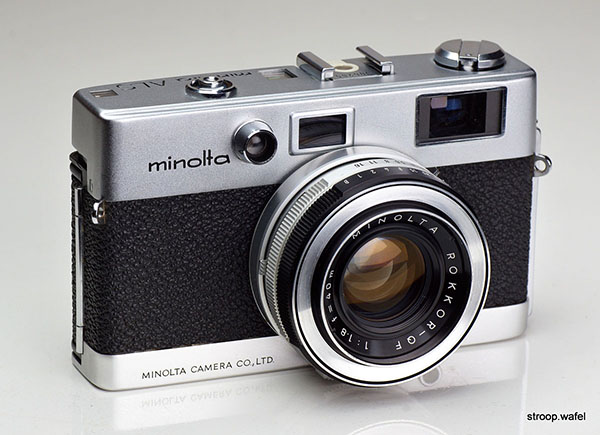
The Minolta ALS, an upgraded Minoltina-S with CdS light meter and hot shoe. This is one of the rarer Minolta compacts, perhaps due to the succes of the Hi-Matic range which featured automatic exposure.

The top view of the Minolta ALS was very similar to that of the Minoltina-S, the main difference between the cameras being the light meter and hot shoe.
Electro Shot
The 1965 Electro Shot was a rangefinder with CdS light meter and fully automatic exposure control, which set both aperture and shutter speed of the Seiko ES shutter electronically. It was the first camera to ever do so! Minolta was aptly proud of this and tried to appeal to the photographer's inner geek by putting a circuit diagram on the title page of the manual and printing: "It is a complete automatic EE camera with an electronic programmed shutter, consisting of 6 transistors and 3 diodes." It also featured a warning light in case there was too little light. The exposure system worked by setting the aperture based on the available light and opening the shutter for the time needed to expose the photograph properly. The full range of light values was achieved by using fast shutter speeds for small apertures and slow speeds for large apertures.
The main drawback of the camera has to be the position of the battery compartment: one had to partially wind the wind lever to get to it. Fortunately it would last up to two years according the manual. The lens was a fast and excellent 40mm f/1.8 Rokkor-QF with 6 elements in 4 groups.
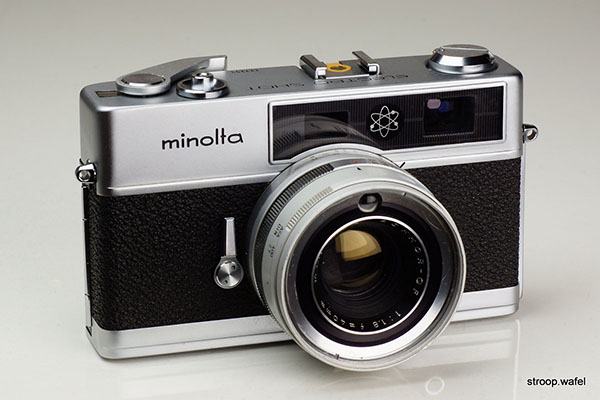
A Minolta Electro Shot with fully electronic shutter control. The lever to the left of the lens is the time delay. Note the electron symbol between the rangefinder windows, also found on the Yashica Electro range and the Ricoh 800EES amongst others, but not on the Ricoh Super Shot and Canonet QL19E which use the same Seiko ES shutter and were introduced not long after the Electro Shot.

Top view of the Electro Shot with hot shoe and new style lever wind.
Minolta 24 Rapid
The 1965 Minolta 24 Rapid was Minolta's venture into the Rapid cameras, which featured film cassettes instead of film rolls. The film was transferred from one cassette into another, negating the need to rewind the film and protecting the already exposed film if the camera back was accidentally opened. It also automatically set the ISO rating of the film by means of little tabs on the Rapid cassettes. The film was the same as standard perforated 135 film but this model took 24x24 mm photographs. The lens was a 32mm Rokkor, but still provided a standard lens image because of the smaller film frame.
The camera no longer had a selenium light meter cell like the previous cameras, but a CdS unit in the lens which needed a 1.35V battery to operate. Unfortunately the batteries are no longer available, as they contained mercury and are now banned. The benefit of the mercury battery was that they kept the same constant voltage until the very end of their lifetime, essential for accurate exposure metering. Modern batteries slowly decrease in voltage with use, the best replacements are small hearing aid buds but an adapter or some tinkering is often needed for a proper fit.
The Rapid cassettes were essentially the same as the Karat cassettes used on the Agfa Karat cameras until these switched to standard 135 film. The revival of this film format was thus quite remarkable but did not last long. It was mainly used in cheap instant cameras and the Minolta 24 Rapid was one of the best, if not the best of the bunch. It featured full automatic exposure control but could also be used in either of fully manual, aperture priority or shutter priority modes. It had a rangefinder with the light meter reading projected in the viewfinder window. It is, however, one of the few Minoltas to feature front-cell focussing instead of helical focussing.
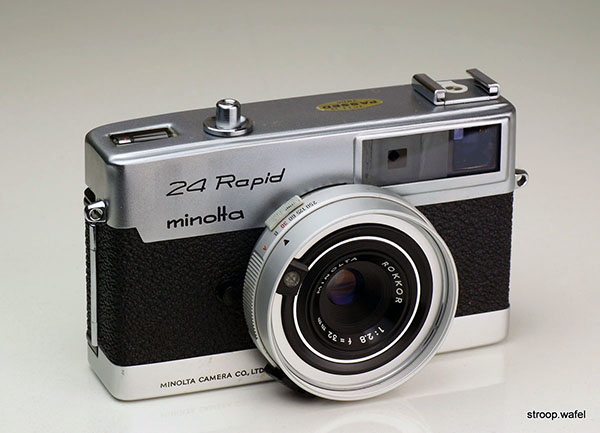
A Minolta Rapid 24, one of the better cameras using the Rapid cassette system. On this model the CdS cell is visible at, rather unusually, about 10 o'clock on the lens. The camera can also be used without battery in full manual mode.
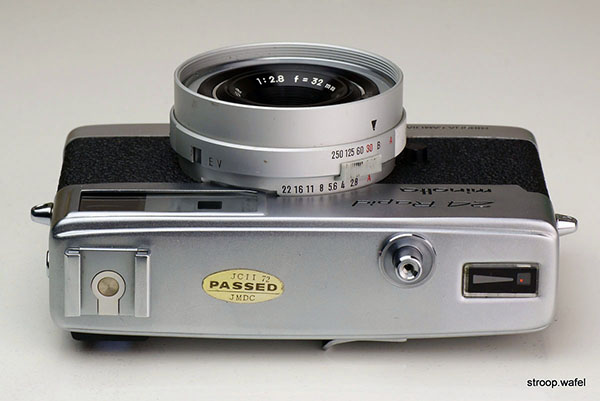
Top view of the Minolta Rapid 24 showing the various automatic and manual controls on the exposure rings.

Rear view of the Minolta Rapid 24 with opened back and loaded with Rapid film. The film transports from right to left on this image, opposite of Minolta's with 135 film.


(left) Detailed view of where the supply cassette goes. Note the little tab indicated with an arrow, this is pushed in by the Rapid cassette when it is put in place and determines the ISO setting. Pushing this lever without a cassette in place changes the EV setting of the exposure meter, as one would expect.
(right) Four different Rapid cassettes marked C, D, E and G (from left to right). Note how the tab length increases, this determines the ISO setting. Tab lengths are 1.0, 1.5, 2.5 and 3.0 mm, respectively, and the matching speeds are DIN 17, 18, 20 and 21, or ISO 40, 50, 80, 100. No shooting fast film with these ones! The physical limit of the push-in tab is about 6mm, equalling ISO 400. This would be an M cassette, not sure one ever existed but one could fairly easily modify a cassette.
Minolta Autopak 700
Staying with the theme of unusual film formats, the 1966 Autopak 700 was very similar to the Rapid 24 in design but took 126 instamatic cassettes. This was a new film format introduced in 1963 by Agfa and was essentially 828 film (135 paper-backed rollfilm) in a cassette format, which avoided having to wind the film leader onto the wind spool. Despite its convenience the film format was not a great success mainly because the cameras using it were typically cheap plastic point-and-shooters. The Minolta Autopak 700 was a welcome exception, although Minolta also produced several cheap plastic Autopaks. The Autopak 700 came in two slightly different versions, one with the name on top of the camera, another with the name on the front of the camera next to the Minolta logo.

A Minolta Autopak 700 with Rokkor 38mm f/2.8 lens, one of the better cameras taking instamatic or 126 cassettes.
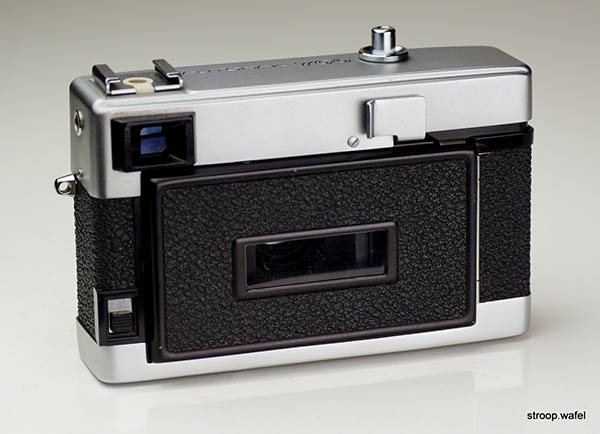
Rear view of the Autopak 700 showing the somewhat clunky looking back door to fit the 126 film cassettes, which protruded about 5mm from the back of the camera. The rectangular window would show the film frame number.

View of the insides of the Autopak 700. Note the square film gate.

As the Instamatic cameras did not need a separate frame counter or a rewind knob, the top housing of the Autopak 700 only had release button and hot shoe. The lens unit was identical to the Rapid 24.
Minolta AL-F
The 1967 Minolta AL-F was a rather compact rangefinder camera designed for easy flash photography with a somewhat slow f/2.7 and rather wide 38mm lens. It had a ring on which the flash guide number could be selected and the camera would automatically set the exposure. It also had manual speed controls but no B setting. The aperture setting would be visible in the viewfinder window. It featured a hot shoe and a coupled rangefinder with parallax correction.
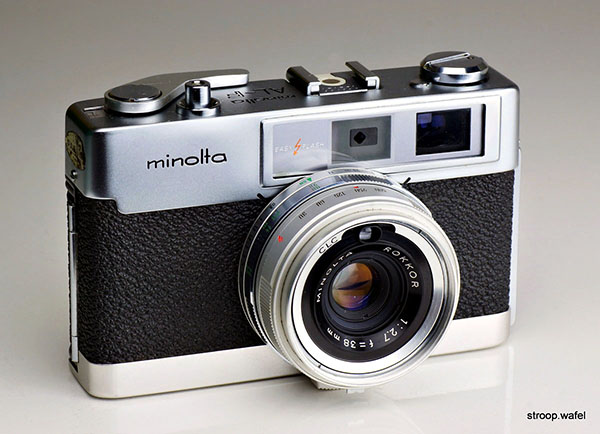
A Minolta AL-F with CdS light meter. This one came with a still working KX625 1.35V mercury battery inside. These batteries were banned in the mid-90s for environmental reasons. This caused a headache for photographers who relied on the very steady voltage these batteries provided. They also had a long lifetime, as this one proves.

A Minolta AL-F from above, note the ring with flash guide numbers on the lens.
Minolta AL-E
The 1968 Minolta AL-E was essentially an upgraded version of the Minolta ALS, sporting the same lens but with the CdS cell moved to just above the lens so the exposure would automatically adjust for filters mounted on the lens. It also added an automatic exposure mode, but it did loose the slow shutter speeds, the slowest speed being 1/15s instead of 1s.
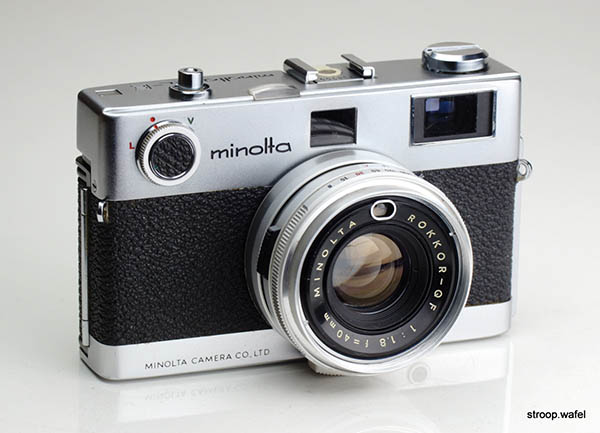
A Minolta AL-E with Rokkor-QF 40mm f/1.8 lens. The function of the dial at the front left is not fully clear to me; the L setting locks the shutter release after winding the film, the V would appear to be related to the time delay, but the time delay lever is located on the lens and works fine on the standard middle setting. An instruction manual would help, but these are hard to come by, if you have one please let me know!

A Minolta AL-E from above, showing the aperture indicator, which I think was unique to this model.
Hi-Matic 7
The Hi-Matic series was Minolta's hugely successful main line of compact cameras surviving until 1984. The 1963 Minolta Hi-Matic 7 was the second one, after the original Hi-Matic, and the first one with CdS light meter, which needed to be powered by a battery. It was quite a large and heavy rangefinder camera, to me unnecessarily so as it only added automatic exposure and a hot shoe to the features of the much more compact Minoltina-S. It was quite similar to its contemporary, the Konica Auto-S2. It had a fully automatic exposure mode as well as manual controls, so it was a versatile shooter. The exposure was projected as LV values in the viewfinder window, which also showed a parallax corrected frame.
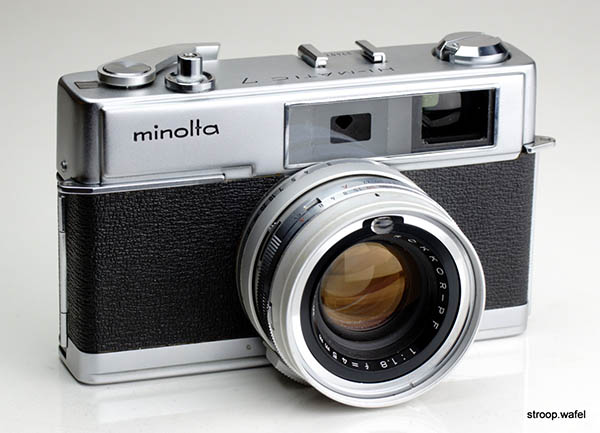
A Minolta Hi-Matic 7 with Rokkor-PF 45mm f/1.8 lens, defeating the trend of increasingly compact cameras.

Top view of the Minolta Hi-Matic 7. Not much going on there. The light meter needle was visible in the viewfinder, hence no light meter window was present on top of the camera.
Ansco Autoset CdS
I generally avoid rebranded cameras, but I had to make an exception for the 1964 Ansco Autoset CdS, as it was a unique model not produced under the Minolta name itself. Ansco sold several Minoltas, including the Uniomat range (as Anscoset) and the first Hi-Matic (as Autoset). The Autoset CdS was a bit of an odd duck, as even though it looked like a Hi-Matic it did not have a rangefinder but a viewfinder with projected zone focussing symbols. In addition, the CdS cell was located in the top housing, behind the little window above the ASA/DIN indicator window, not on the lens. In fact, the lens looked more like the ones on the Uniomats/Anscosets. All in all an interesting model that due to the lack of a rangefinder, presumably could be marketed at a cheaper price than the Hi-Matics.
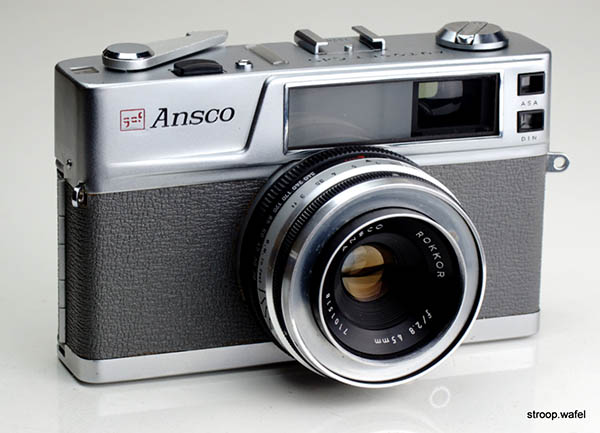
A Ansco Autoset CdS. The name 'Rokkor' on the lens gave away its Minolta heritage.
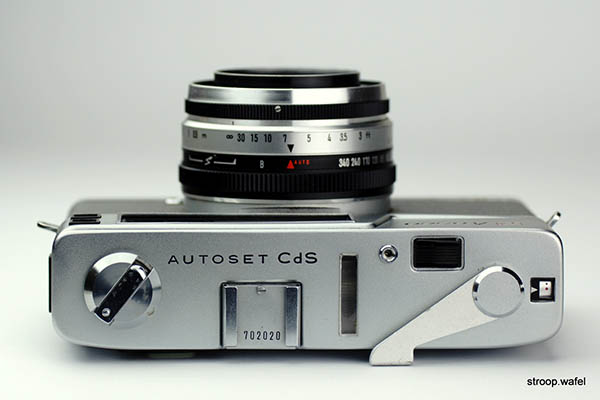
Top view of the Ansco Autoset CdS. Note the black shutter release button, different from the standard Minolta one and requiring a separate remote release socket. The long rectangular slot was the window that allowed projection of the light meter needle in the top of the viewfinder.
Hi-Matic 7S
The Hi-Matic 7s was introduced three years after the Hi-Matic 7 and introduced several small improvements, including the addition of a hot shoe and a more advanced light metering system. Nice features, but if it was worth the upgrade I am not sure, the Hi-Matic 9 was probably more attractive. There was also a version with a completely black body.

A Minolta Hi-Matic 7S, defeating the trend of increasingly compact cameras.
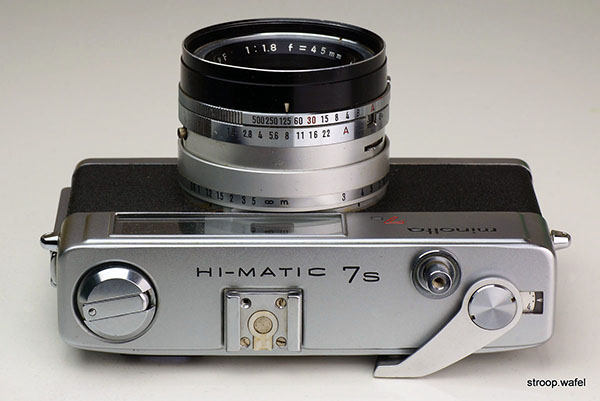
A Minolta Hi-Matic 7S seen from above. The hot shoe was the only difference with the Hi-Matic 7. This example is missing the little insert plate that covers the screws and shows the body serial#.
Hi-Matic 9
The Minolta Hi-Matic 9 was an upgraded version of the Hi-Matic 7S (introduced at the same time) with a slightly faster f/1.7 six-element lens, an improved flash exposure system (as indicated by the 'Easy Flash' markings on the front) and the addition of slow shutter speeds (1 and 1/2s). It also sported a small film indicator window in the back that would show a red mark if film was loaded in the camera. Like the 7S, it had a fully automatic as well as a manual mode.
The camera needed a battery for the light meter to work (so did the Hi-Matic 7s), but the camera itself would work fine without it. Although the PX-625 cells the camera used are no longer available, zinc cell hearing aid batteries are a convenient replacement. The camera features a battery check function on the lens barrel, which will help determining if the replacement battery is up to the job.

A Minolta Hi-Matic 9 with fast 50mm f/1.7 Rokkor-PF and its original box as well as Hi-Matic 9 branded lens cap.
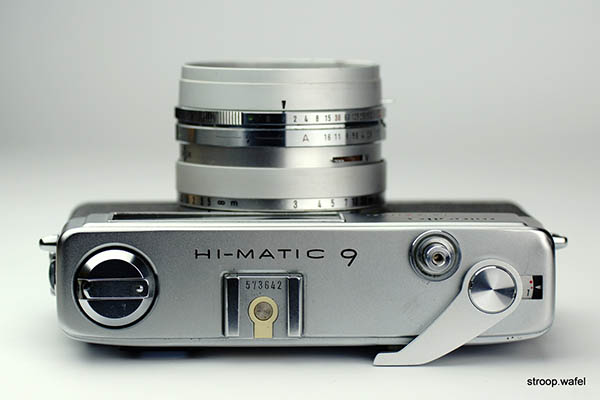
Top view of the Minolta Hi-Matic 9, identical to the 7S other than the lens ring: white here but black on the 7S.
Minolta Hi-Matic 11 Super 3 Circuit
The 1969 Minolta Hi-Matic 11 was essentially a Minolta 9 but without any manual controls, it operated either in shutter priority with a fasted speed of 1/500s or in fully automatic mode. Compared to the Hi-Matic 9 it added a little extra window in the viewfinder that would show the shutter speed ring on the lens.
The camera would work without battery as it defaulted to f/1.7 aperture and still fired the shutter. Considering the relatively slow fasted speed of 1/500s, this is when neutral density filters would have come in handy!
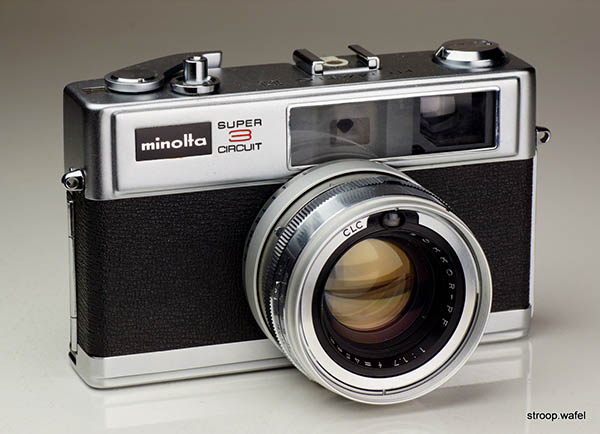
A Minolta Hi-Matic 11 with fast six-element f/1.7 Rokkor-PF lens. The designation Super 3 Circuit apparently referred to the three shooting modes: shutter priority, automatic exposure and automatic flash exposure.
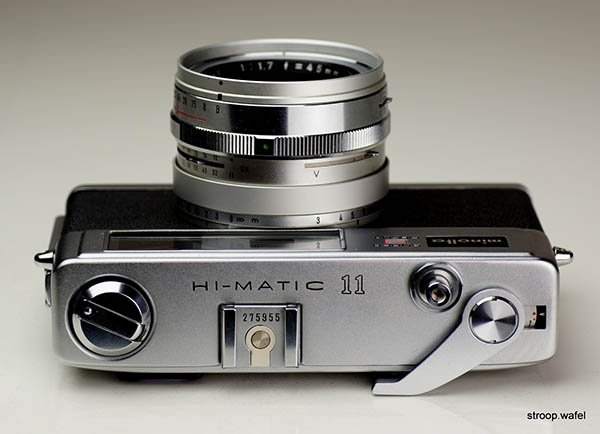
Top view of A Minolta Hi-Matic 11, again very similar to that of the Hi-Matic 7S but here with shiny silver lens ring.
Minolta Hi-Matic C
The 1969 Minolta Hi-Matic C was a fully automatic compact camera with a collapsible lens as its most defining feature. The lens would pop out when the green button was pushed in, to push the lens back one would have to push the green button at the same time as the lens. It had no rangefinder but it did feature an extra little window in the corner of the viewfinder through which the markings on the lens were visible. With the lens collapsed, one would see the 'weather setting', which was a sun or cloud symbol which defined the shutter speed. With the lens extended one would see the zone focus symbols. So one could check the exposure setting, pop the lens, determine focus and take the shot all whilst looking through the viewfinder.
The camera's CdS light meter would determine the aperture. A needle showed this value in the viewfinder for little reason, as one could not change the exposure other than the 'weather setting'.
The camera also allowed easy flash photography, as flash guide numbers were marked on the lens next to the weather symbols. On the back of the camera was a table indicating the flash working range for flashes with different guide numbers.
A version in black without collapsing lens was sold as the Hi-Matic 5.
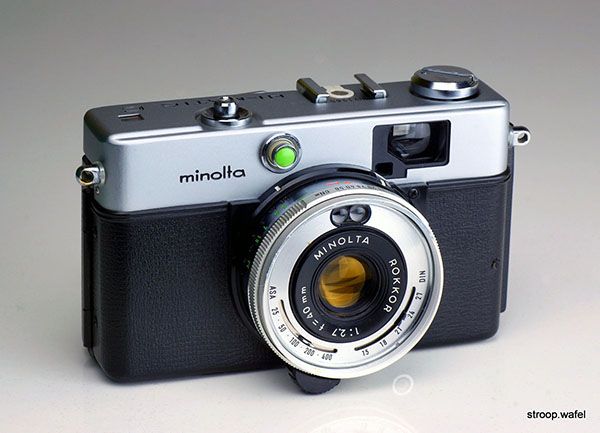
A Minolta Hi-Matic C with its pop-out lens and green jewel-like lens release button. Also note the little spy window in the bottom-left corner of the viewfinder that shows exposure and focus markings on the lens.

A Minolta Hi-Matic C from above with lens collapsed and extended. The extension was so little that it barely made a difference for the portability of the camera, perhaps it was designed to be able to see the focus (lens out) and exposure settings (lens in) through the viewfinder separately.
Minolta Hi-Matic E
The Minolta Hi-Matic E was the top model of a new generation of Hi-Matics introduced in 1971, the Hi-Matic E, F and G. They were very compact and had a new black wind lever on top of the camera. They did look rather similar to their competitors such as the Ricoh 500 G and Olympus 35 series. They were availble in chrome as well as black versions.
The Hi-Matic E featured a rangefinder and a fast Rokkor-QF f/1.7 lens. It was fully automatic, although on the back it has a manual switch but that only served to override the automatic flash exposure, e.g., for fill-flash. The exposure mechanism even worked with very low light levels, down to 2s exposures at f/1.7. The camera needed no less than two 640 mercury batteries, which are not avaible anymore due to environmental concerns and proper replacements are not easy to find. It won't work at all without them.
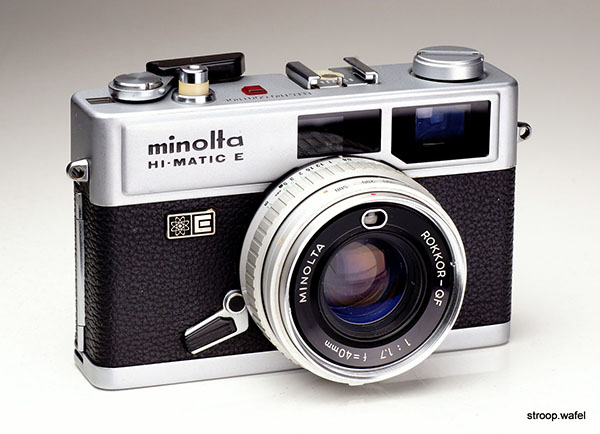
A Minolta Hi-Matic E with f/1.7 40mm Rokkor-QF. On this example the time delay lever is stuck (next to the lens), it is supposed to stick upwards when not in use. Perhaps it will come magically back to life once I find a set of suitable batteries.

Top view of the Minolta Hi-Matic E showing the newly styled wind lever and the battery check light. The latter would also light up while depressing the shutter release button during exposures longer than 1/30s, the shutter needed to be held down until the light would do out.
Minolta Hi-Matic F
The Hi-Matic F was the less advanced but more compact little brother of the Hi-Matic E. The lens was a slower f/2.7 38mm Rokkor and the camera missed a time delay. Also, the focus ring, flash exposure and film speed adjustments all switched position compared to the Hi-Matic E. There was no manual override of the flash system. Nevertheless, it featured an excellent lens and the same wide-range electronic exposure system and viewfinder indicator lights as the Hi-Matic E, but in a much more portable package.

A black Minolta Hi-Matic F rangefinder with 38mm f/2.7 Rokkor lens in Seiko-ESL shutter.
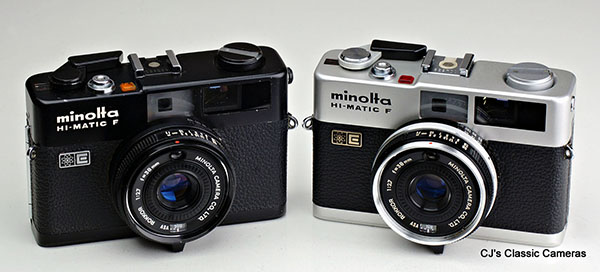
Left or right?
Minolta Hi-Matic G
While the Hi-Matic E and F were rangefinders, the Hi-Matic G was a simple viewfinder that used zone focussing. It was about the same size as the Hi-Matic F. The camera was fully automatic only, but did have a dedicated flash mode. The lens was a relatively slow f/2.8 38mm Rokkor. It also missed the time delay and battery test function of its more advanced cousins. The exposure system was less advanced, with aperture and shutter speed indicated with a needle in the viewfinder and a minimum shutter speed of 1/30s. It only needed a single 675 battery.
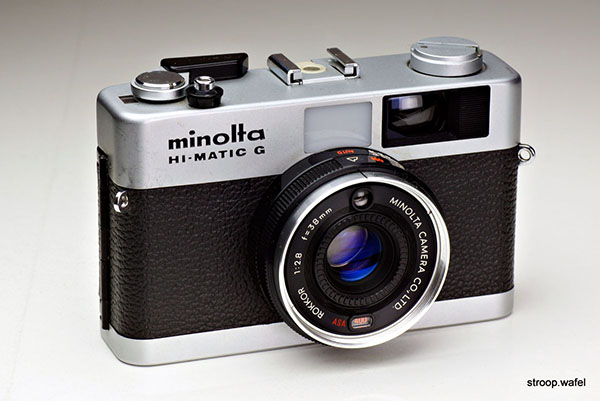
A Minolta Hi-Matic G with f/2.8 38mm Rokkor.
Minolta Hi-Matic 7SII
Despite its name, the 1977 Hi-Matic 7SII can also be considered part of the Hi-Matic E to G range, as it was essentially an Hi-Matic E upgraded with a fully manual mode. When compared to the original Minolta Hi-Matic 7S, the version II was considerably smaller and lighter, and it had a slightly shorter focal length.
The automatic mode was strictly speaking only a shutter priority mode, but as the aperture value was projected in the viewfinder it was easy to select a specific value by changing the shutter speed. Unfortunately the light meter would not function in manual mode, therefore for over or underexposing reliably one needed to measure the exposure in automatic mode, set the aperture manually to the value indicated by the light meter, and then adjusting the shutter speed one or two stops up or down. This camera was very similar to the Konica Auto S3 but was introduced about four years later, near the end of the Konica's life cycle.
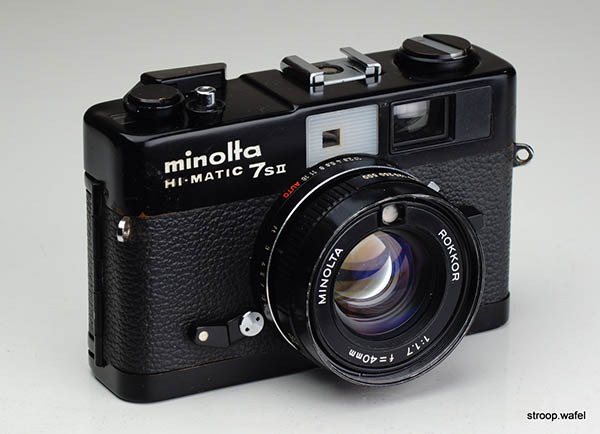
Black version of the Minolta Hi-Matic 7SII compact camera with 40mm f/1.7 Rokkor lens in Copal shutter. Most likely this was the same lens as on the Hi-Matic E, so with six elements in four groups.
Vivitar 35SE / Prinz 35ER
That's right, not Minoltas. There's quite a bit of contradicting info on the internet about these cameras and several like it: the Revue 400SE and the Konica Auto S3. They are often presented as rebranded Minolta Hi-Matic 7SII and were allegedly made by Cosina (meaning so was the Hi-Matic 7SII). It is true that all these cameras are very similar. They all have similar or perhaps the same 40mm f1/.7 lenses, apart from the Konica which has a 38mm f/1.8 Hexanon, and very similar Copal shutters, all with the same range of shutter speeds. Differences were subtle and mostly cosmetic. However, only the Hi-Matic 7Sii had an option for manual aperture control in addition to the shutter speed priority auto-exposure mode the other cameras had. The other cameras had a flash control ring where the aperture ring was on the Minolta. The Konica on the other hand had an adjustable fill-flash system aided by the light meter. So really, the Vivitar 35SE, Revue 400SE, Prinz 35ER were all slightly simplified compared to the Minolta and the Konica, and in my opinion more similar to the Hi-Matic E in functionality. Nevertheless, they were great little shooters, very light and small with fast lenses. Just don't say they are Hi-Matic 7SII.

Vivitar 35SE with 40mm f/1.7 (Rokkor?) lens in Copal shutter.
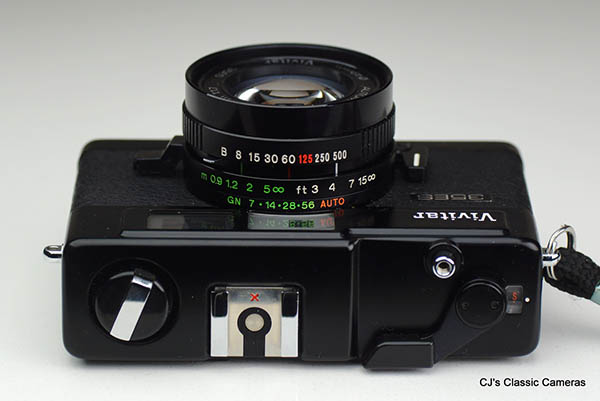
Top view of the Vivitar 35SE showing the exposure control rings around the lens, which are (starting at the top) shutter speeds, focus distance (in feet and meter) and flash guide number/ auto exposure setting. These are very similar to the Hi-matic 7Sii, expect that the lower ring was the aperture control ring.
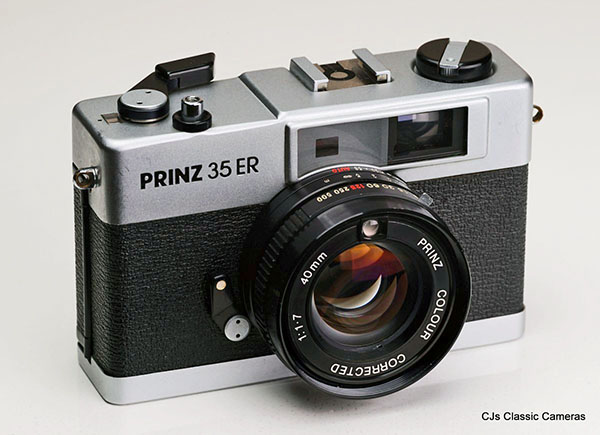
And here is the Prinz 35ER with 40mm f/1.7 lens in Copal shutter, nearly identical to the Vivitar but with a chrome top instead. Despite the German sounding name, Prinz cameras were mostly rebranded Japanese cameras imported and sold by Dixons in the UK.
Minolta Prod 20's
The Minolta Prod 20's was a retro style point and shoot camera made in the early 90s. Almost everything was automatic about the camera, focus, exposure, flash, winding, even loading and rewinding the film. The only manual control was a lever next to the lens, which activated the selftimer and the shutter lock. The Prod 20's had quite a unique look with a metal face plate and a prominent flash unit in the top corner. It's cute, but personally I'd like a bit more control over the camera.
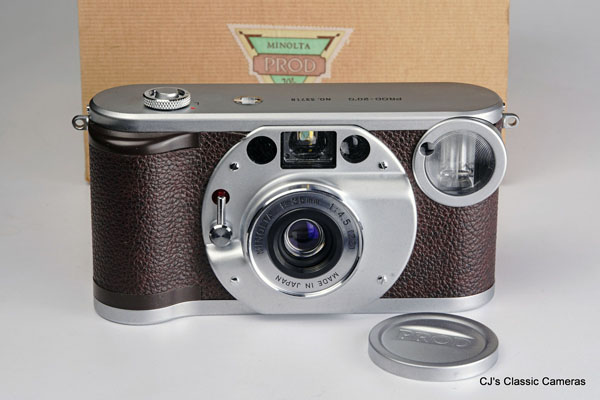
Minolta Prod 20's with 35 mm f/4.5 lens. A surprisingly slow lens, perhaps meant to always give a decent depth of field. I found the flash performance also a little disappointing, it tends to overexpose close objects and with daylight film the colours weren't that great.
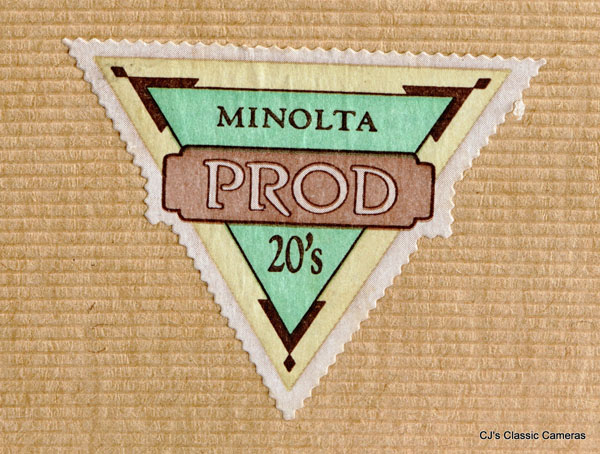
| I am a sucker for fun little details of camera packaging and here the Prod 20's doesn't disappoint - look at this cute little postage-stamp style logo. |
Minolta Mini slide projector
Not a camera but a pretty funky piece of kit: the Minolta Mini slide projector. This small and very portable projector from the mid 1950s came with a wide angle Rokkor lens that allowed slide projection in small spaces. It did not not contain a fan, so it was also very quiet. Drawbacks? Well, the image was not that bright. It did, however, come with an auto-changer which was operated manually but could hold about 40 slides at a time. It was well build with lots of nice shiny chrome and it still works. A slightly updated model was the very similar looking Minolta Mini 35 slide projector, which allowed a separate fan unit to be mounted (the 'Minolta Blower') and therefore could take a brighter bulb. There was also a Minolta Mini 16 for small format slides.

Minolta Mini slide projector with Chiyoko P-Rokkor 75mm f/2.5 projection lens and its single slide changer accessory. Move the mouse over the image to see the projector folded up.
| 
